Joel Bellviure, the main colorizer at Cassowary Colorizations, started this project out of a desire to learn through historical rediscovery.
Cassowary Colorizations has colorized photos for both media publications as well as regular people (by accepting their commissions) but no matter where an image comes from, it is treated with attention and care.
If you take a look at Cassowary Colorizations' social media, you'd quickly understand just how meticulous their work really is. Every picture comes with a detailed description, providing not only visual information but important historical facts behind them as well.
More info: cassowarycolor.com | Instagram | Facebook
#1
Jacob C. Miller (August 4, 1840 - January 13, 1917) was a private in company K, 9th Indiana Infantry Regiment, and was wounded in the head near the Brock Field at the Battle of Chickamauga on the morning of September 19, 1863. The ball impacted in Miller's head during the Civil War, but luckily the buck didn't penetrate his skull. This extract is from a contemporary newspaper: «His name is Jacob Miller and since Sept. 19, 1863, he has lived with an open bullet wound in his forehead. For a number of years the bullet remained in his head but piece by piece it fell out till now. It is thought none of it remains in the wound. During the time it was in the head it at times would produce a stupor, which sometimes would last two weeks, it being usually when he caught cold and produced more of a pressure on the brain. At other times delirium would seize him and he would imagine himself again on picket duty and would tramp back and forth on his beat, a stick on his shoulder for a musket, a pitiful object of the sacrifice for freedom. As these pieces of lead gradually loosened and fell out he regained his usual health and is now at the age of 78 years, one of the most, if not the most, remarkable survivor of the Civil war.»
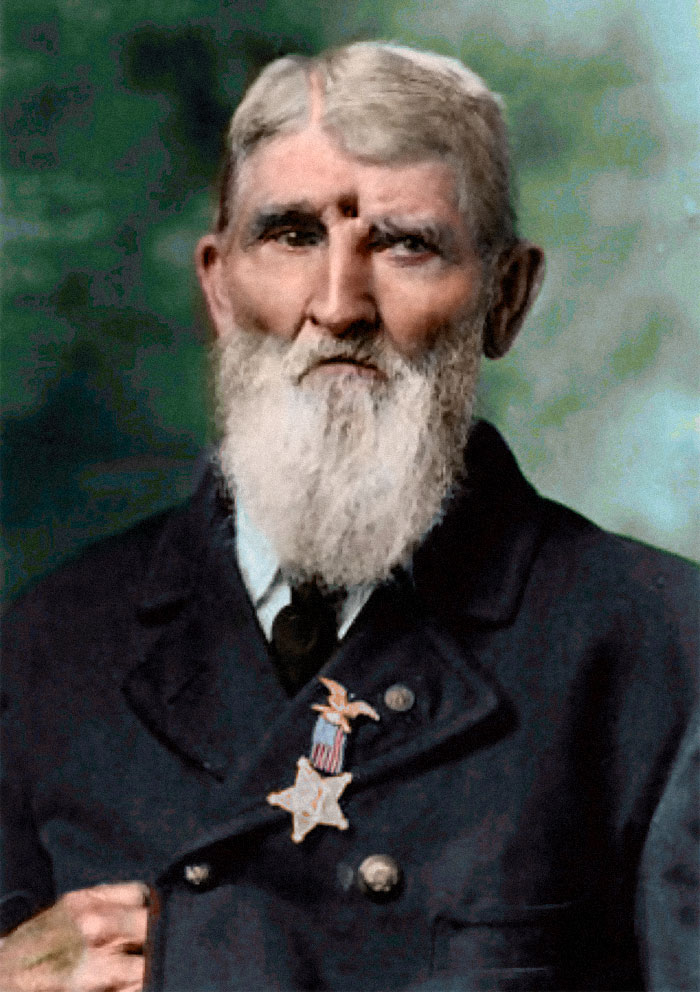
Image credits: Cassowary Colorizations
#2
An Italian Alpino mountain specialist ziplines from one peak to another, c. 1917. Although ziplines might be seen as an indicative of amusement or military operations, they have been used as easy and cheap transportation method during centuries, specially on mountainous regions, such as China’s Yunnan, where even ziplines were used instead of bridges. In Australia, for instance, they were used for delivering food, cigarettes or tools without the need of crossing valleys and rivers, something adapted in war times.
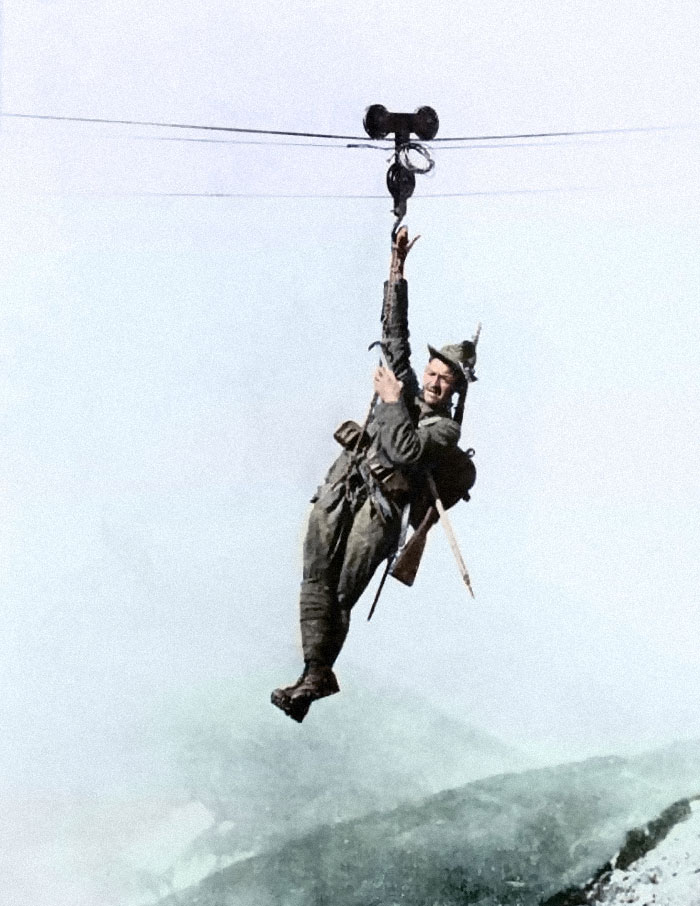
Image credits: Cassowary Colorizations
#3
US soldier from the 11th Airborne Division shares a bit of chocolate with a local girl, 1946, Japan. One of the main reasons for using chocolate in armies is the high energy content it has and how easy to carry it is. It has a light weight and long durability and was usually carried in simple pockets by any kind of soldiers. During World War Two, the best-known chocolate was the Scho-Ka-Kola, destined to German Luftwaffe pilots in order to obtain fast and to keep their minds active during the combat. On the other hand, the American Army started serving Hershey’s chocolate to their troops. The result was the so-called "Logan Bars". This same company created in the 90s the "Desert Bar" designed for the operations in Middle East "Shield and Desert Storm", although the soldiers’ opinion of the soldiers on its flavour did not contribute to its later commercialization. This time it was the last one that the American Army used chocolate as energetic food, since in our days it is being replaced by synthetic food which, although it will be of help, will surely not give so much happiness to the troops than a good ol’ piece of tasty chocolate. By the way, you can still buy Scho-Ka-Kola and Hershey’s, which is great. 1946, John Florea
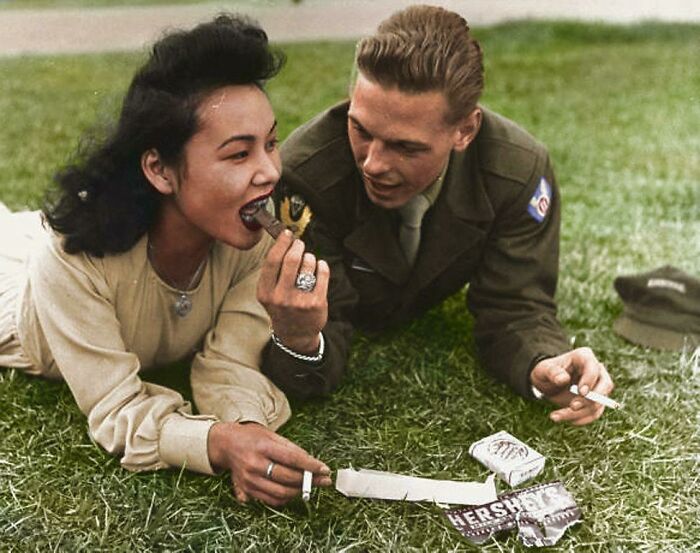
Image credits: cassowarycolorizations
#4
U.S. soldier wearing a Brewster Body Shield, 1917. The Brewster Body Shield, also and more accurately known as Brewster Body Armor, was the first American body armour to really be useful developed by and for the United States Army in World War I. Essentially, it consisted of a breastplate with an attached headpiece, both able to stop machine gun bullets at an average speed of 820 m/s. The main problems were its heaviness, which was nearly 28 kg. and its discomfort for soldiers. An adapted armour of 5 kg was later created, which fit close to the body, and was considered more comfortable.
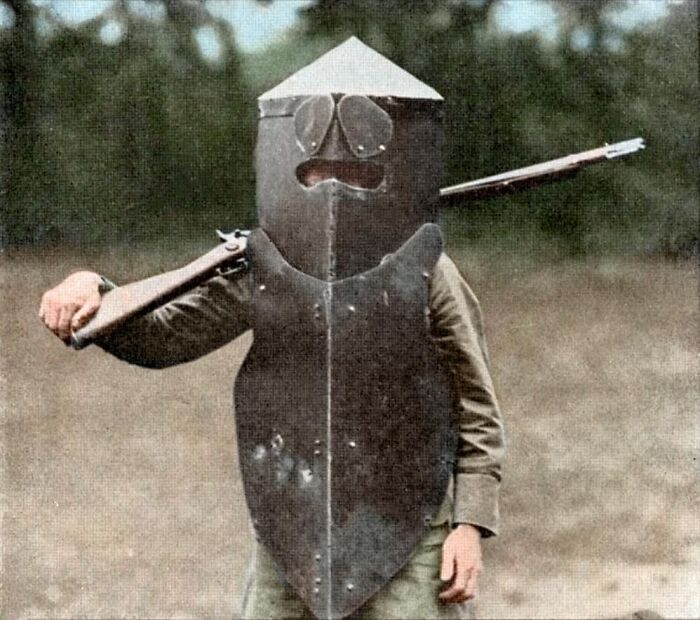
Image credits: cassowarycolorizations
#5
An original colour picture from World War II. While most pictures taken both by press and propaganda offices, and, of course, soldiers, were in black and white, several journalists or servants were giving new colour cameras. Innovations such as Kodachrome (1935) and Kodacolor (1942/1958) brought never-seen-before results to photography and nowadays are a faithful guide to colourisers.
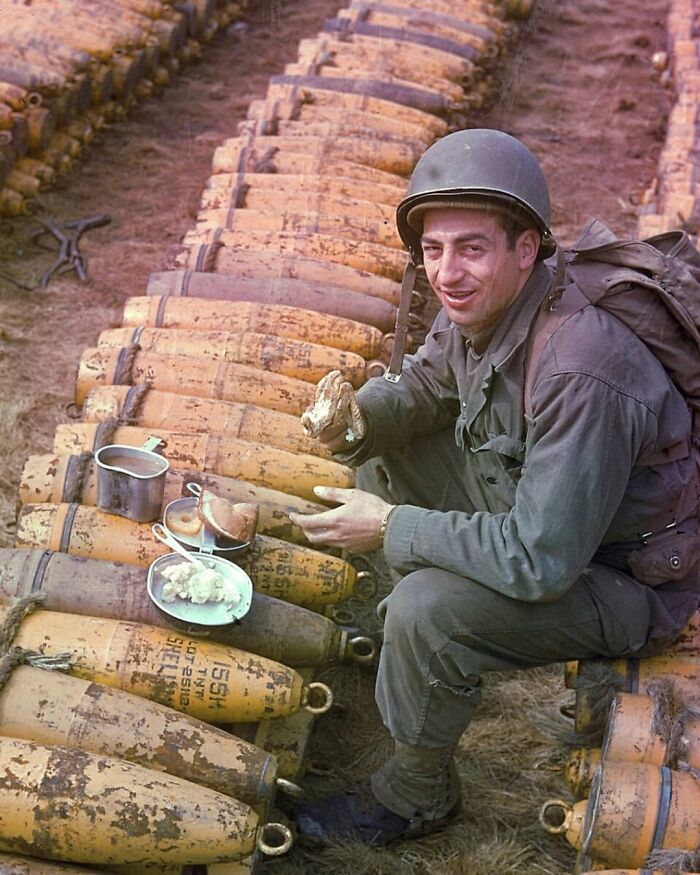
Image credits: cassowarycolorizations
#6
I’ve been waiting more than a week to make this public. A month ago, we published a monographic book about colorization on Germany and France in WWI. The books illustrate the war in the Western Front with detailed attention in the captions of more than 80 pictures in full color colorized by me. It is named ‘German & French Armies in the Great War’ and has been published by Soldiershop.
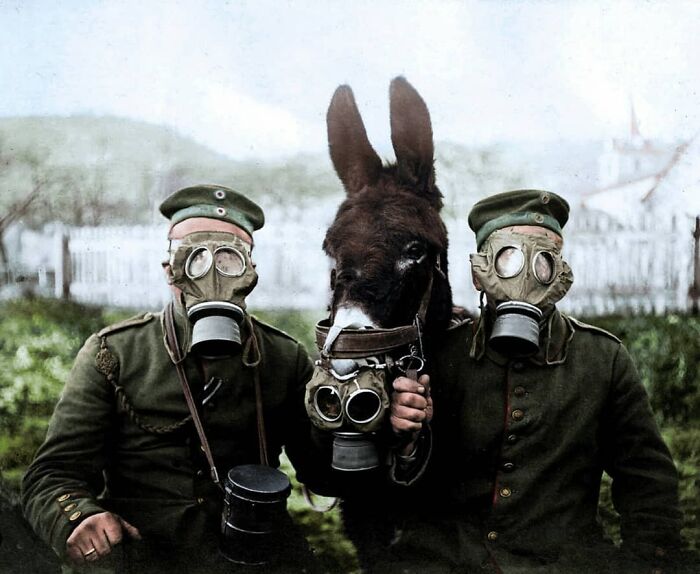
Image credits: cassowarycolorizations
#7
Two female Russian snipers shooting from a trench somewhere in the Eastern Front, 1943. Sniper’s baits were common in the Second World War, and were supposedly born during World War One, with even whole mannequins portraying infantry soldiers. Here depicted, a helmet bait, that would trigger the enemy soldier to shoot from the other trench and therefore to be within range of the allied sniper.
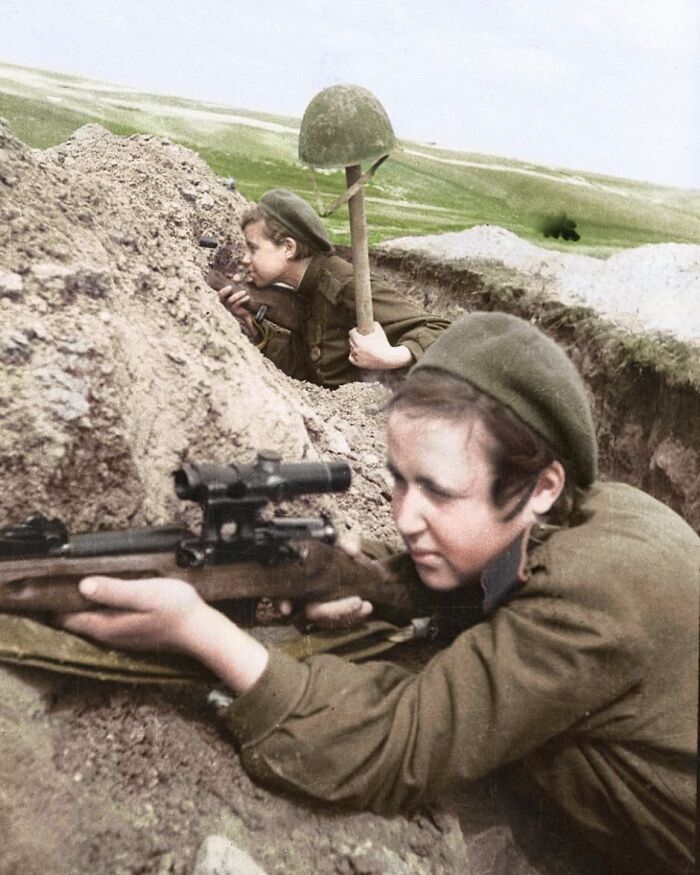
Image credits: cassowarycolorizations
#8
Happy Australia Day! An soldier at an advanced Allied base, with his pet kangaroo, location unknown, most likely NQ. Pets were something relatively new in WWII, but amazingly common. Although since the beginning of war animals had been used for different proposes it wasn’t until modern times when animals where used as company and not as means of military ends. Several battalions, divisions or armies had their own pets; however, platoons used to find lost animals because of the war itself and took them around. That’s why most of the pets we can find in WWII photos are usually attached to an only individual. Frequently, soldiers came across with those animals, which could be dogs, cats, bears, kangaroos, and even cassowaries -check my very first post-, and trained them, which eventually led to the creation of capable animals that would help in combat, more than simply pets. 10/09/1942, John Earl McNeil
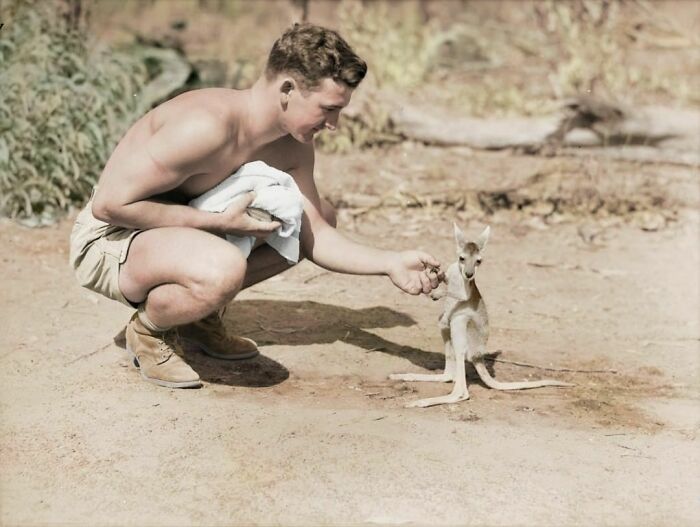
Image credits: cassowarycolorizations
#9
A few of the thousands of wedding rings the Nazis removed from their victims to salvage the gold. U.S. troops found rings, watches, precious stones, eyeglasses, and gold fillings, near the Buchenwald concentration camp, Germany, May 5, 1945. I’m preparing a series on the Holocaust, where I’ll try to represent not only the Jew extermination, but the repression to minorities and the work of the Einsatzgruppen as well.
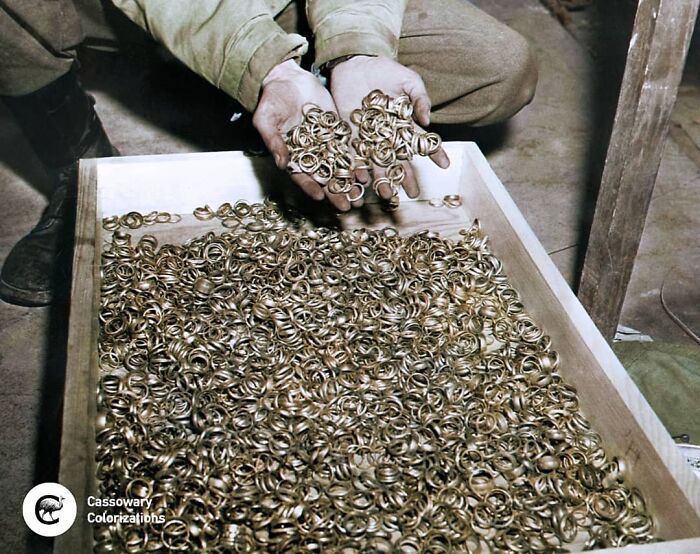
Image credits: cassowarycolorizations
#10
A U.S. soldier lighting a cigarette in Khe Sanh, South Vietnam, 12 April 1971. The Vietnam War, known in Vietnam as the American War, was a war that occurred not only in Vietnam, but also in Laos, and Cambodia from 1 November 1955 to the fall of the city of Saigon on 30 April 1975. It was officially fought between North Vietnam -supported by the Soviet Union, and China- and South Vietnam -supported by the United States, South Korea, Australia, Thailand and others-, which makes it a Cold War-era proxy war. The Viet Cong’s guerrilla warfare against the U.S. and S.V. forces infringed one of the hardest defeats to the United States, which ended with 58,318 dead and 303,644 wounded. Once the war ended, the North Vietnamese government and the Viet Cong tried to reunify Vietnam. While they viewed the conflict as a colonial war for freedom against France, the U.S. government viewed its involvement in the war as a way to prevent a communist takeover of South Vietnam. 12/04/1971

Image credits: cassowarycolorizations
#11
Afrika Korps, shortened DAK, soldier sitting on two M24 Stielhandgranates in the North African theatre, 1942. Although this picture seems pretty dangerous, the chance that the grenades denotated was very difficult and even those could be neutralised grenades. I’ve just realised that I have hardly even made DAK posts, so I am going to explain a little bit what and how it worked. The Deutsches Afrikakorps was -and this is something people ignore in many occasions- an expeditionary force, not any kind of formation as a division or a battalion, mainly made out of motorised divisions, created in 1941 and handed directly by Adolf Hitler to Erwin Rommel, both having very close relations. The first intention of the force -another ignored fact- was not to conquer or to expand Germany’s colonial control, but to support the Italian fascist forces trying to reconquer Libya, which had had serious trouble. After outstanding military victories, and after the brave yet disastrous fights of El Alamein, the DAK was dissolved on 13 May 1943.
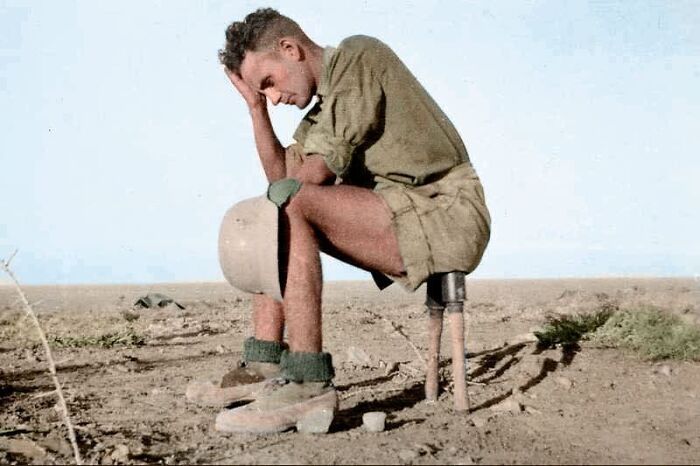
Image credits: cassowarycolorizations
#12
Today marks the 75th Anniversary of the Bombing of Dresden. Here pictured is the destruction of the city as seen from the Rathaus, or town hall, months after the bombing. The bombing of Dresden took place between 13 and 15 February 1945, when 1249 British/American heavy bombers directly attacked the city of Dresden, the capital of the German state of Saxony, dropping more than 3,900 tons of high-explosive bombs and incendiary devices on the own city, destroying 6.5 km² of the city's cultural centre. Up to 25,000 people were killed, most of them civilians, and leaving hundreds without roof. The official version pointed out to a “strategic target” referring to 110 in the area. Half of the attacks occurred directly to the city centre, dropping a total tonnage of 2659.3, the biggest in the whole bombing, and without any rational explanation. Only one raid targeted industrial areas, and three a railroad. Moreover, a considerable part of the actual military and industrial terrain was never bombed, instead a great part of the Dresden cultural landmark with little or none strategic significance was transferred into ashes.
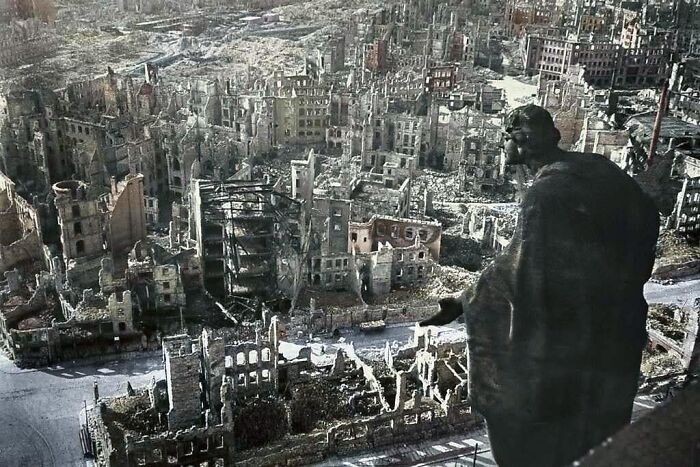
Image credits: cassowarycolorizations
#13
Sergeant Joseph Levin of the American Army Chemical Warfare Service testing a gas mask with his horse “Buddy”, Governor's Island, New York, 1928. This picture has long been credited as a Frenchman during the Battle of Verdun (something incredibly thoughtless because of many indications). More ironically, and what hurts me the most, is that Getty Images credits it as being an early 1930s picture and then, in another shot of the same man and day, as a 1917 picture. After I took some research, I discovered a similar photograph taken the same day in the Popular Science issue of October 1928. It is sad that a corporation as Getty, which charges colossal fees to its photographs doesn’t even bother to make a five-minutes research. I’ve transcribed you the original article: “ARMY DEMONSTRATES A NEW GAS MASK FOR WAR HORSES / Buddy, an Army horse stationed at Governor's Island, New York, is shown wearing the latest mask designed to protect war horses and mules during gas attacks. The bag of the mask fits tightly over the nostrils of the animal and is held in place by straps buckled over its head. Buddy demonstrated the effectiveness of the new protection recently when he carried Sergeant Joseph Levin of the Chemical Warfare Service, through a deadly screen of poison gas without suffering ill effects. Levin is seen wearing the newest equipment developed by Army experts to protect soldiers.” The American Chemical Corps was and still is one of the many branches in which the United States Army is divided. It was created the 28 June 1918, few months before the First World War ended, named the U.S. Chemical Warfare Service (CWS). After the Second World War, its name was changed to the current Chemical Corps. For most of its history, the Chemical Corps was tasked with delivering chemical weapons rather than defending against them.
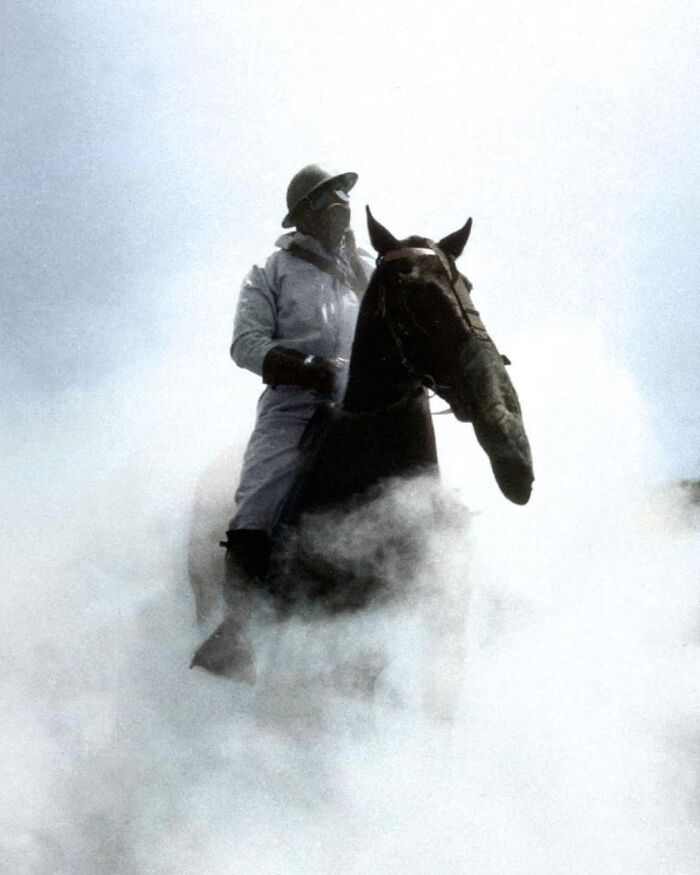
Image credits: cassowarycolorizations
#14
A British cavalry sergeant major instructs an American soldier in bayonet charging at Texas’ Camp Dick. Although the bayonet was developed in the early 17th century in Bayonne (that’s why it’s called “baïonnette”), it was during World War One that this weapon acquired a very well-known paper. Whereas in World War Two weapons had a great range of fire, at the beginning of WWI arms had to be loaded in a very complicated way. With the war staged in the trenches, the sense of a bayonet charge had already extinguished. Attacks like those in the American Revolutionary War could no longer be performed. This eventually lead to soldiers to use bayonets in order to open cans, play games in the mud and, of course, defend themselves against surprise attacks.

Image credits: cassowarycolorizations
#15
Luftwaffe honour guards marching with a goose step in a parade in Berlin, date unknown. The goose step is a special marching step performed on formal military parades and other ceremonies. While marching in parade formation, troops swing their legs in unison off the ground while keeping each leg straight and unbent. The step finds its origin back to the Prussian military drill in the mid-18th century. German and Soviet military advisors spread the tradition throughout the world in the 19th and 20th centuries. Apparently, standing on only one leg reminded soldiers of how geese often stand. The term has acquired a pejorative meaning in some English-speaking countries, since it is deeply related with fascist armies.

Image credits: cassowarycolorizations
#16
An Austrian lance corporal with a thousand-yard stare. I’ve talked with you before about the thousand-yard stares. Do you know where does the expression come from? The phrase was popularized after Life magazine published the painting “Marines Call It That 2,000 Yard Stare” by World War II artist and correspondent Tom Lea. The painting depicts a Marine during the Battle of Peleliu, from whom Lea said: “He left the States 31 months ago. He was wounded in his first campaign. He has had tropical diseases. He half-sleeps at night and gouges Japs out of holes all day. Two-thirds of his company has been killed or wounded. He will return to attack this morning. How much can a human being endure?” 1918
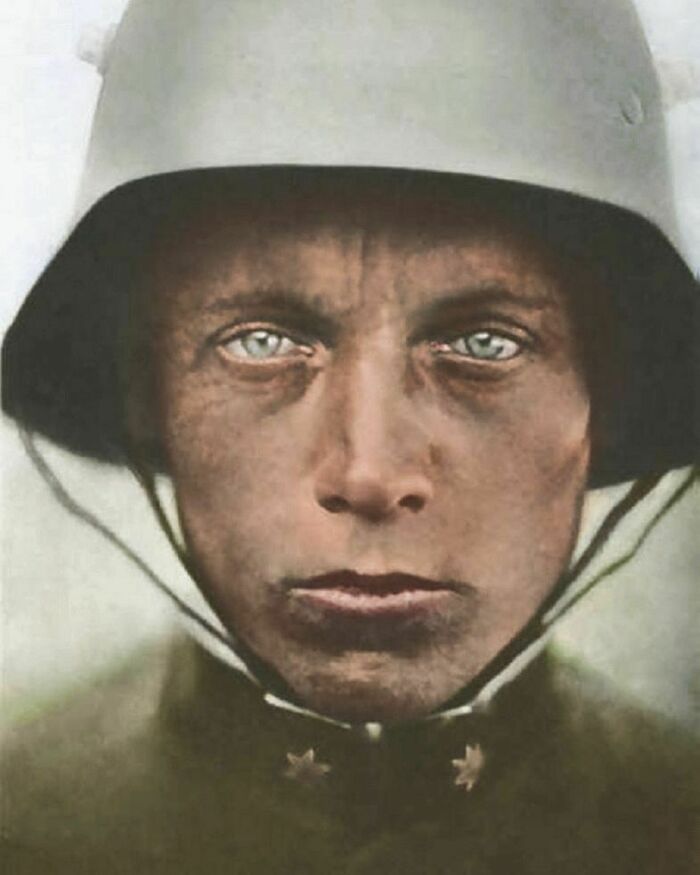
Image credits: cassowarycolorizations
#17
German soldier dives for cover as shell explodes somewhere in the Western Front, 1917. Shells are payload-carrying projectiles that contain an explosive. Shells were and are usually large-calibre projectiles fired by artillery, combat vehicles, tanks, and warships. Shells usually had the shape of a cylinder topped by an ogive-shaped nose for good aerodynamic performance, in World War I, ogives were typically two circular radius head. But after that war, ogive shapes became more complex and elongated. 1917

Image credits: cassowarycolorizations
#18
A picture I did two years ago. Men (and a dog) of the Seaforth Highlanders rest in a trench, near La Gorgue, France, August 1915. Note how the bayonets are fixed, possibly pointing to the staging of the picture, as in 95% of the occasions. Swipe to see "8 Section panorama: Taken from: - La Gorgue. Direction: - Auber, Neuve Chapelle.".
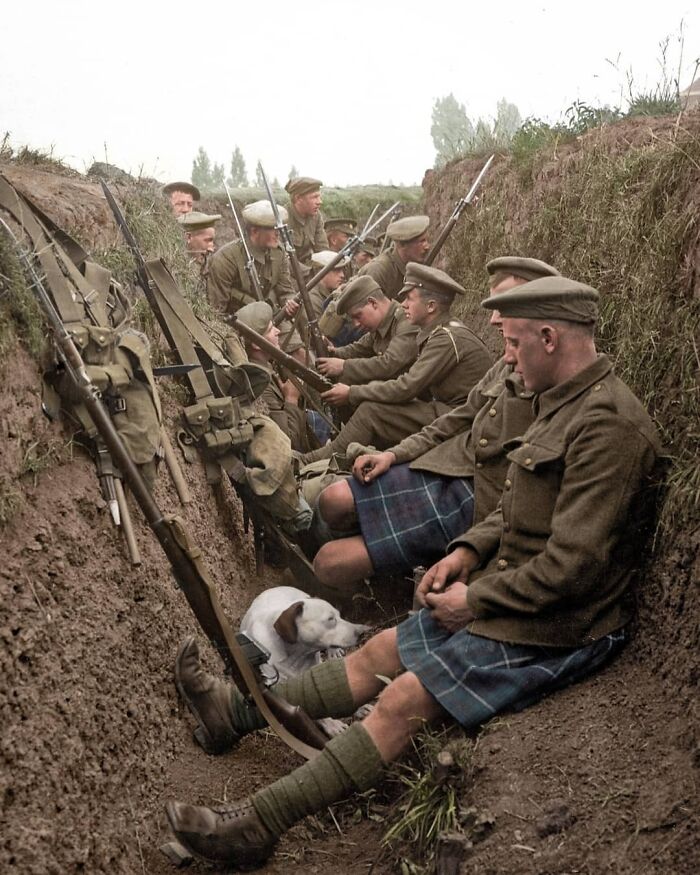
Image credits: cassowarycolorizations
#19
Soviet soldiers uncovering and neutralizing Tellermine 43 anti-tank mines planted in the road by retreating German Wehrmacht Engineers following the Battle of Kursk, Kursk Oblast, August 1943. The metal probe was used to identify any sign of buried mines. The Tellermine 43 was a German circular steel cased anti-tank blast mine used from 1943 to the end of World War Two. A simplified version of the Tellermine 42, over 3.6 million Tellermine 43s were produced by Germany. Copies of the mine were produced by several countries including Denmark (M/47), France (Model 1948) and Yugoslavia (TMM-1).

Image credits: cassowarycolorizations
#20
An Italian officer descending the Mombrone during his last exercise, 1906. The Italian Cavalry School, created in 1823, was responsible for the training of all armed forces cavalry staff. Every officer of the Cavalry School in Pinerolo (near the Alps) was required to go down “the descent of Mombrone” before they left the school. The 6 metres drop from the window of a ruined castle about three miles from Pinerolo was considered a test of nerve. Similar training exercises were taken at Fort Crook, Nebraska.
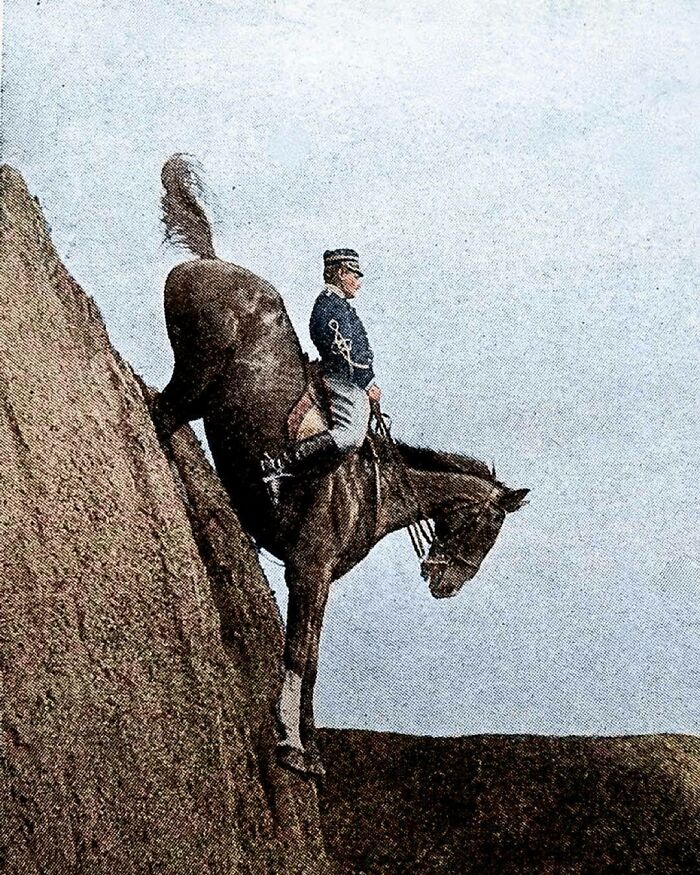
Image credits: cassowarycolorizations
#21
An unknown American soldier in Summer Service Uniform mocking Hitler’s moustache with a hair comb. Depicted in his uniform, a Combat Infantryman Badge, a Good Conduct Medal and an unknown medal. The Good Conduct Medal is one of the oldest military awards in the United States Armed Forces. Although the U.S. Navy's variant of the Good Conduct Medal was established in 1869, the Army version wasn’t scheduled until 1941, and the Air Force on, until 1963. The medal is awarded to any active-duty enlisted member of the United States military who completes three consecutive years of "honorable and faithful service, which means not having any non-judicial punishment, disciplinary infractions, or court martial offenses. During wartime, the Good Conduct Medal may be awarded for one year of faithful service, or even awarded posthumously. c. 1944
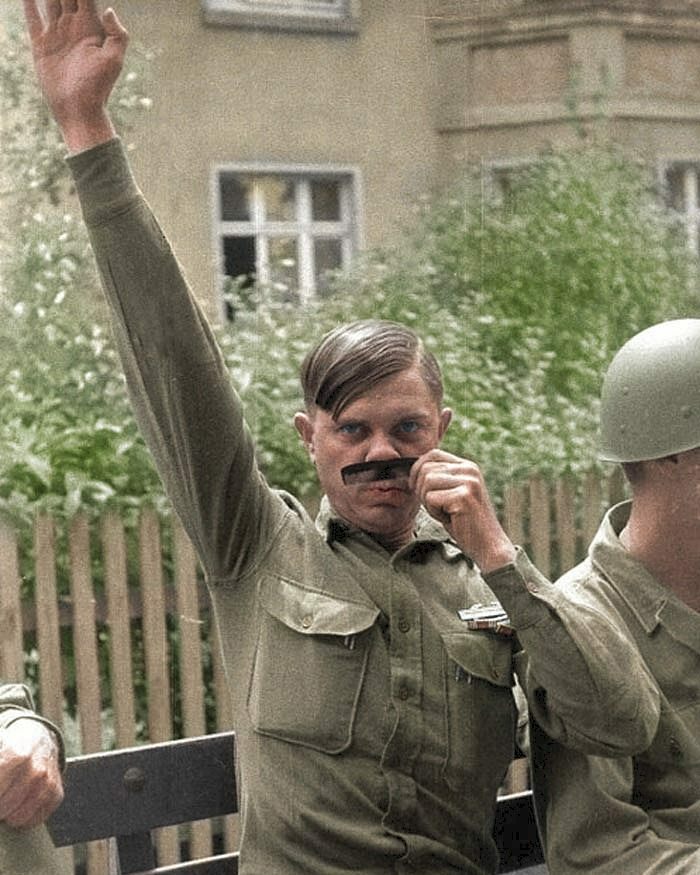
Image credits: cassowarycolorizations
#22
A Heinkel He 111 crashing directly into the sea, date and place unknown. This He 111 is only one of thousands that wrecked during World War Two, and that currently lie beneath the silence of the seas. Only on the little island of Malta, it’s reckoned to be 800 wrecked planes, a third part of the 2700 planes that participated along the Allies and the Axis in the bombing of Malta.
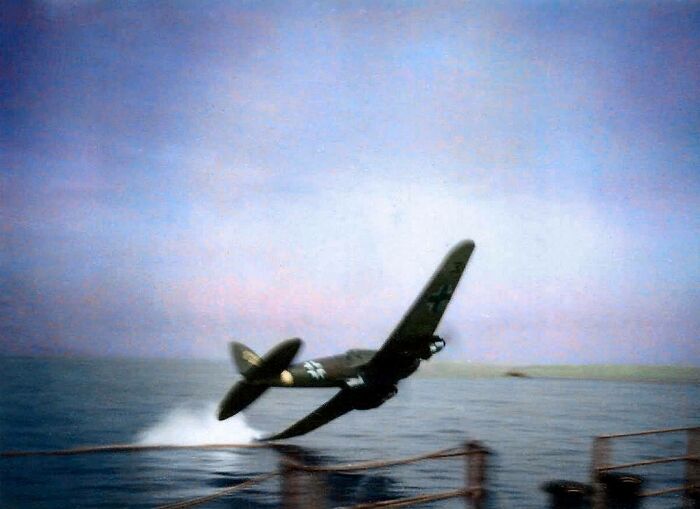
Image credits: cassowarycolorizations
#23
An American corporal aims a Colt M1895 installed on an elephant in a purely propagandistic picture, 1914. Although this picture is staged, elephants have been used for military purposes for centuries. War elephants were first employed in India, the practice spreading out across south-east Asia and westwards into the Mediterranean, with eventually Hannibal crossing the Alps to invade Rome along with 38 elephants. Generally, the war elephant's main use was to charge the enemy, breaking their ranks and instilling terror. Their most famous use in the West was by the Greek King Pyrrhus of Epirus and in significant numbers by the armies of Carthage, including as told briefly by Hannibal. In the Middle Ages war elephants had already declined and its use it’s nowadays rare or inexistent. Sadly, nowadays, elephants are still used around the world for unfair purposes and animal abuse is still persistent.

Image credits: cassowarycolorizations
#24
This is my grandfather, in 1958, joking with his two subordinates as he imitates a Moroccan soldier in the streets of Sidi Ifni, during the last Spanish Colonial War, the Ifni War. A week ago, I wrote an article on Medium in an awesome project started by historicstories, about his experience, and you can easily find it by searching ‘My grandfather and The Ifni War’ on the Internet. I leave you with a little fragment here. There is a popular habanera in Catalonia that says, ‘My grandfather went to Cuba, on board of the Català, the best ship on the Navy of the Overseas Fleet’. The song, called ‘El meu avi’, was written exactly 50 years ago, in 1968, but the lyrics remember a much farther reality. […] The Spanish–American War of 1898 does certainly still provoke a little spite. It was then, during the long summer of 1898 when the Spanish political disputes, the officers’ excessive pride, and the estrange diseases of the Cuban forests destroyed forever the Spanish Empire. At the end of Franco’s dictatorship, a group of certain Moroccan tribes, led by Ben Hammu, took up arms in the Sahara colony, claiming a land they considered theirs. At that time, my grandfather was doing the compulsory military service in Paterna, a small town on the outskirts of Valencia. Although antimilitarist, he agreed to do the promotion test and was immediately promoted to corporal. […] Although education in Spain during the dictatorship was of an ominous nature, my grandfather was allowed to study one more year than the Franco regime used to sponsor. It was for this reason that, to his surprise, he was sent to the topographical unit; he had achieved the highest mark in the Army’s mathematical examination. […] Want to read more? Head to the web.

Image credits: cassowarycolorizations
#25
Pfc Joseph E. Day (1918-2009), in underpants, holds a puppy named "Invasion" in a German helmet, Le Dezert, France, 1944. Concerning underwear, it was largely an invention of the 1930s. On 1935, an engineer named Arthur Kneibler, designed the world's first briefs in Chicago. During World War II, elastic waistbands and metal snaps gave way once again to button fasteners due to rubber and metal shortages. Undergarments were harder to find as well, since soldiers abroad had priority to obtain them. By the end of the war, Jockey and Hanes remained the industry leaders in the US, but Cluett, Peabody and Company made a name for itself when it introduced a preshrinking process called "Sanforization", invented by Sanford Cluett in 1933, which came to be licensed by most major manufacturers. 1944
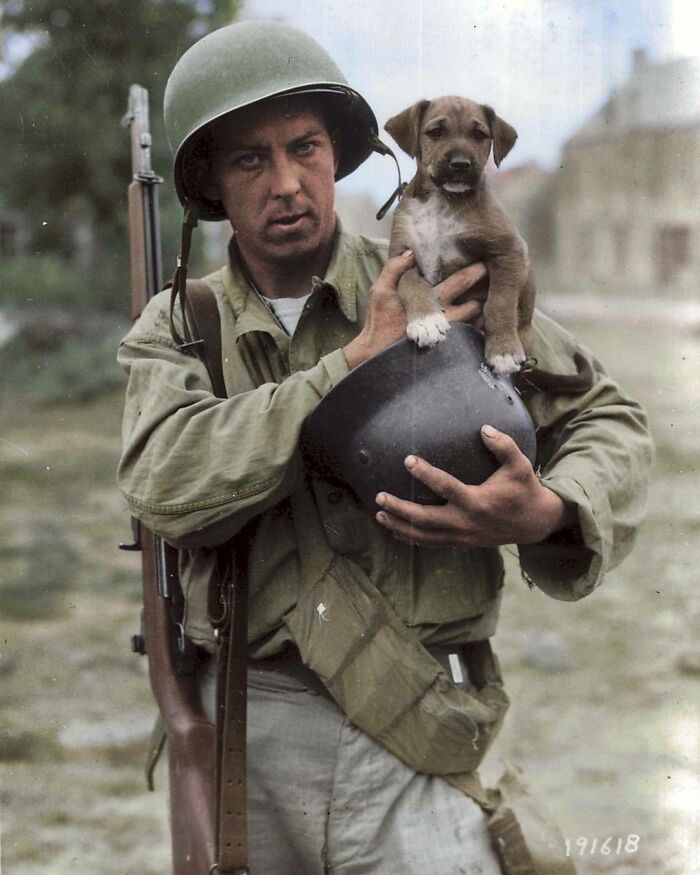
Image credits: cassowarycolorizations
#26
Finnish artillery corporal Niman sculping a feminine figure in sand, during the Continuation War, Valkjärvi, c. 1943. If you want to know more about Finland in WWII, I prepared a long ago a series of three posts about the Winter War, the Continuation War, and the Lapland War. Now, let’s talk about unique things about Finland. The country was the only one that sided with Germany, but in which native Jews and almost all refugees were safe from persecution. It was the only co-belligerent of Nazi Germany which maintained democracy throughout the war. It was also the only belligerent in mainland Europe to do so.
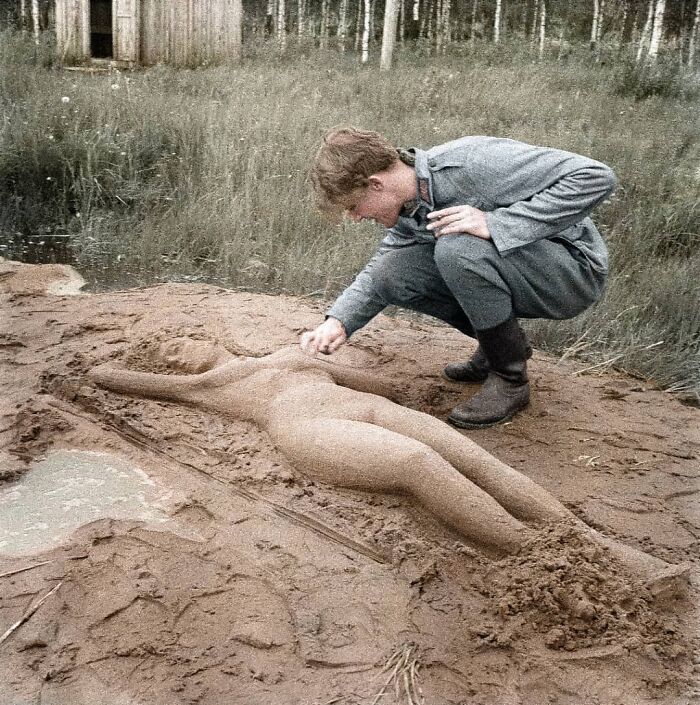
Image credits: cassowarycolorizations
#27
German Mountain troop, awarded with the Infantry Assault Badge during a celebration, c. Summer 1943. Since it’s nearly impossible to make a serious post about this picture, I leave you with a joke my grandfather used to tell me. The Führer was once being driven in his amazing Mercedes by the German countryside, to a small location in Prussia to give a war meeting. Halfway there, some stones from the road he was going through, which was in very bad condition, punctured a wheel and the Mercedes was stamped on a fence, killing a pig that was eating nearby. Angry and hysterical, the Führer shouted to his driver to go to the nearest farm to seek help. The driver, fearful, ran to the farm where he had run over the pig. Five hours later, he appeared in front of the Führer with a bottle in his hand. The dictator, extremely angry at the wait, and seeing that he did not come with help, asked him what he had been doing. "You will see my Führer," said the driver clearly drunk, "I went to the farm and told the villagers that I was carrying Adolf Hitler in my car when, on the road, I ended up killing the pig. And then, they started to congratulate me, and offered me all the bottles of champagne they had. "
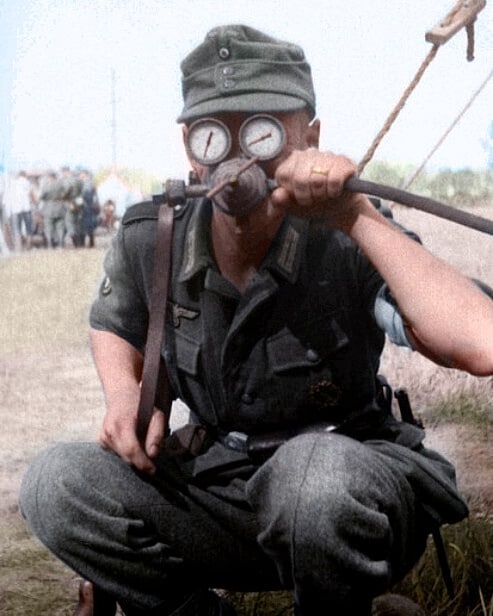
Image credits: cassowarycolorizations
#28
German and Hungarian soldiers from the 503rd Heavy Panzer Battalion on a Tiger II tank in Budapest, Hungary, October, 1944. The 503rd Heavy Panzer Battalion was the only tank unit to go to Budapest. This unit was equipped with Tiger I tanks and Panzer IIIs. In 1944, it was re-equipped with the new Tiger II, like depicted in this photo. The battalion participated in both Eastern and Western Fronts during World War II. Eventually, the battalion became part of the newly formed Panzer Corps Feldherrnhalle as the Feldherrnhalle Heavy Tank Battalion. The battalion saw action in Normandy during the Operation Overlord, as well as in Kursk and Kharkov. I’ve done some research and found that its commanders survived the war and recently died in 2003, 2005 and 2011. 10/1944, Faupel

Image credits: cassowarycolorizations
#29
Military parade on the fifteenth anniversary of the Bolshevik Revolution, with a Red Army Detachment Passing the Lenin Mausoleum, 1933. The Lenin's Mausoleum is situated in the Red Square of Mosco. Lenin’s preserved body has been on public display there since shortly after his death in 1924, with rare exceptions in wartime. Aleksey Shchusev, the designer of the building, built a monumental granite structure incorporates some elements from ancient mausoleums, such as the Step Pyramid, the Tomb of Cyrus the Great and, to some degree, Temple of the Inscriptions. 1933, Georgi Anatoliévitch Zelma

Image credits: cassowarycolorizations
#30
Hitler announces the declaration of war against the United States to the German Reichstag, 11 December 1941. Four days before, the United States had declared war solely on Japan. The offhand decision by Adolf Hitler provoked the United States to declare warto Germany the very same day, thus mobilising troops to both fronts. Source: Bundesarchiv, Bild 183-1987-0703-507

Image credits: cassowarycolorizations
#31
Austrian-Hungarian shock trooper experimenting with grenade-throwing techniques in the training base of Levico, March 1917. Levico, nowadays Italy, was in World War One part of Austria-Hungary, and had a battalion from the 1st Kaiserjäger Regiment stationed there. The population was moved to Austrian inland, and so the area was left only for military practices.

Image credits: cassowarycolorizations
#32
Wojtek the Bear with a fellow Polish soldier, Iran, 1942. Wojtek (1942-1963) was a brown bear purchase at a railroad station in by Polish II Corps soldiers who had been evacuated from the Soviet Union. He was eventually enlisted officially as a soldier with the rank of private, and was subsequently promoted to corporal, fighting in several battles in various fronts. After the war, mustered out of the Polish Army, he was billeted, and lived out the rest of his life, at the Edinburgh Zoo, where he died in 1963, aged 21.
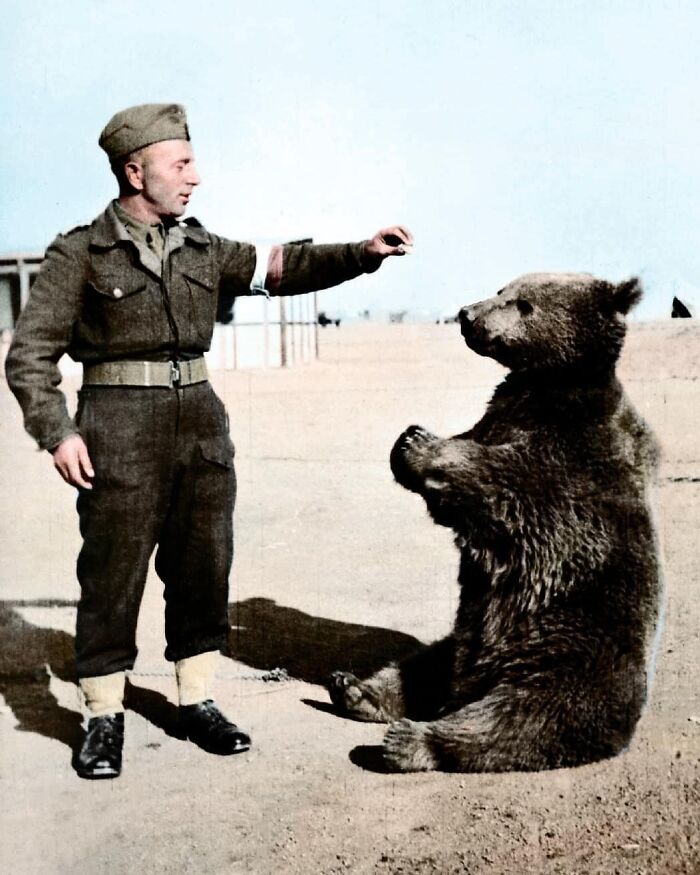
Image credits: cassowarycolorizations
#33
An exhausted American medic returning from the front during the Battle of the Bulge. Combat or Field medics in WW2 were military personnel prepared in a medical basic training, responsible for providing first aid and frontline trauma care on the battlefield. However, they could assist to other units even preparing patients for operations, making beds, or serving as cooks. Geneva Convention completely prohibits medics from using weapons. Medics could use a weapon to protect a casualty, but not themselves. Quoting Stephen Ambrose, "It was the universal opinion of the frontline infantry that the medics were the bravest of all".
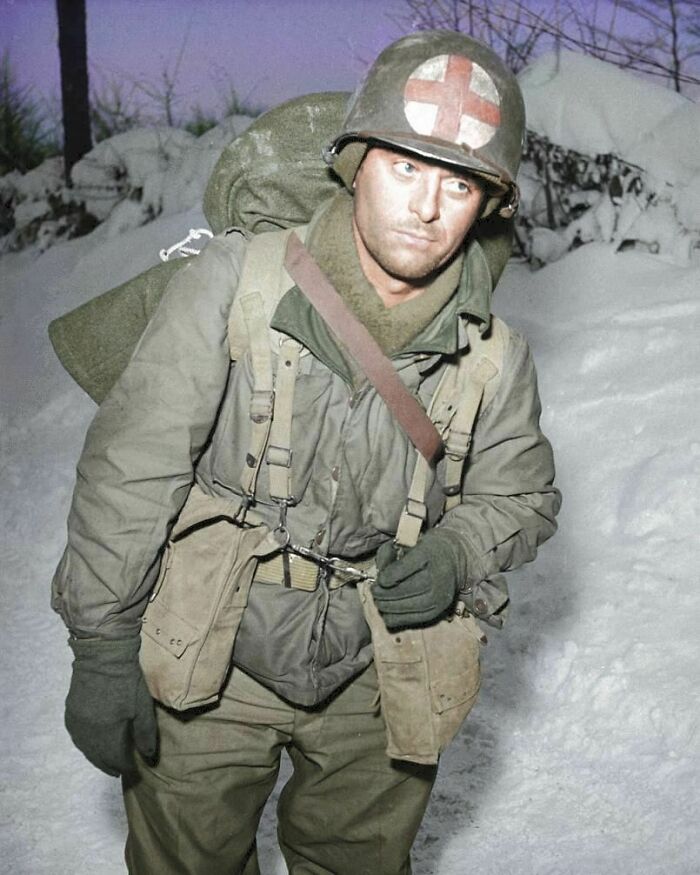
Image credits: cassowarycolorizations
#34
German NCO Heins Sarhander after having fallen asleep, Holland, September 1940. During the Second World War, soldiers would sleep in trenches, in very uncomfortable positions. In the rearguard, companies would be deployed in tents or distributed in the homes of the occupied population.

Image credits: cassowarycolorizations
#35
American troops on board a landing craft heading for the beaches at Oran in Algeria during Operation Torch, November 1942. Today I was reading a Victor Hugo’s poem which made me think why couldn’t I do something rather original: composing a poem while colorizing a picture, evoking the picture in words. I’m deeply sorry if this seems irreverent, but here it goes. The bitter weaving holds the sound of the darkest scream beneath the bank. The sewed badge in the shoulder dies with the moans of white, red and black. As the ship approaches the dying shore, Its breath embosoms the crimson sand. And, as the filth of an unborn child, the men jump into a shore of wrath. The helmets hold the hope of most, the grenades, the hands of twenty more, the uniforms turn into a deeper moan and the brave, gloomy men pray and cry without even reaching the rage’s coast. They shout the word of a dratted god, they confess their duties to the ghost of a flowing glory; today may be gone. And the water embraces them all, with the sorrow of a widow’s cough, and it spits them all into the wall of blood, darter, and expired goals. Now, the fourteenth weave tries to bend the moral of the mysterious men who perished in the glazed arms of a far, pitiful, unknown land.
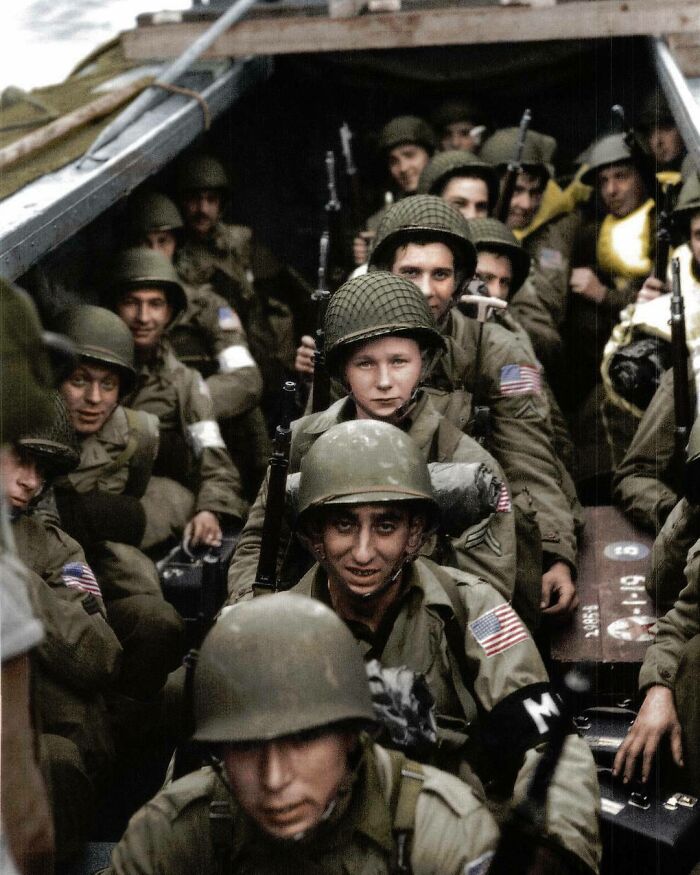
Image credits: cassowarycolorizations
#36
A dummy is bayoneted during a demonstration at Sarafand, Palestine, 11 November 1942. Although Palestine did hardly not see any combat during WW2, as it did during WW1, the British had several units there. The Palestine Regiment was an infantry regiment created in 1942, during the Second World War. The regiment was deployed to Egypt and Cyrenaica, but most of their work consisted of guard duty and rarely saw combat. However, some Palestine Regiment members were killed in Benghazi, where they fought heavy battles against the German units. The Palestine Regiment consisted of Jews and Arabs, conscripted in Mandatory Palestine, until its reformation in 1944. From 1944, the Jewish military subunits of Palestine Regiment became the basis to form the larger Jewish Brigade, which took part in World War II effort of the Allies in Europe. 11/11/1942, Lieut. McLaren

Image credits: cassowarycolorizations
#37
Swedish volunteers in the Finish Amry training with a ROKS-2 flamethrower in action in the woods near the village of Niinisalo, during Continuation War, on July 1, 1942. The ROKS-2 was a Soviet flamethrower, designed not to draw attention so the fuel and gas tanks were concealed under a sheet-metal outer casting that resembled knapsack; the flame projector was designed to resemble a standard Mosin–Nagant rifle. The purpose of this was to prevent the operator from being specifically targeted by the enemy. The Finnish designation for captured ROKS-2 units was liekinheitin M/41-r. Captured Soviet flamethrowers saw some use by Finnish forces during the Continuation War. They were operated by two-man teams of combat engineers. They were well regarded by the Finns, although flamethrowers of all kinds saw little use by Finnish forces. 01/07/1942

Image credits: cassowarycolorizations
#38
Inmates of the Ampfing subcamps in Germany after having been liberated by U.S. Third Army troops, Germany, 4 May 1945. Subcamps are a lesser known aspect of the concentration camp system in Nazi Germany. Prisoners in the Waldlager V and VI, located near the town of Ampfing, were housed in barracks partially submerged in the ground with soil-covered roofs designed to camouflage the structures from Allied aerial reconnaissance.

Image credits: cassowarycolorizations
#39
Austrian soldiers loading a 10 Mod. 1908 Mortar at Levico, October 1916. This is another picture from my book “The Great war in color: Italian & Austrian front” from soldiershoppublishing.

Image credits: cassowarycolorizations
#40
75 years of Casablanca. Today I woke up in a friend’s house, without having slept too much. Still with half-closed eyes, I opened my phone and the news popped up: today it marks the 75 anniversary of Casablanca. I don’t know what the other passengers might have thought of me, colorizing frenetically in the train back home, while, of course, trying to not fall dead due to lack of sleep. Here it is, my last homage to one of the best films ever made.
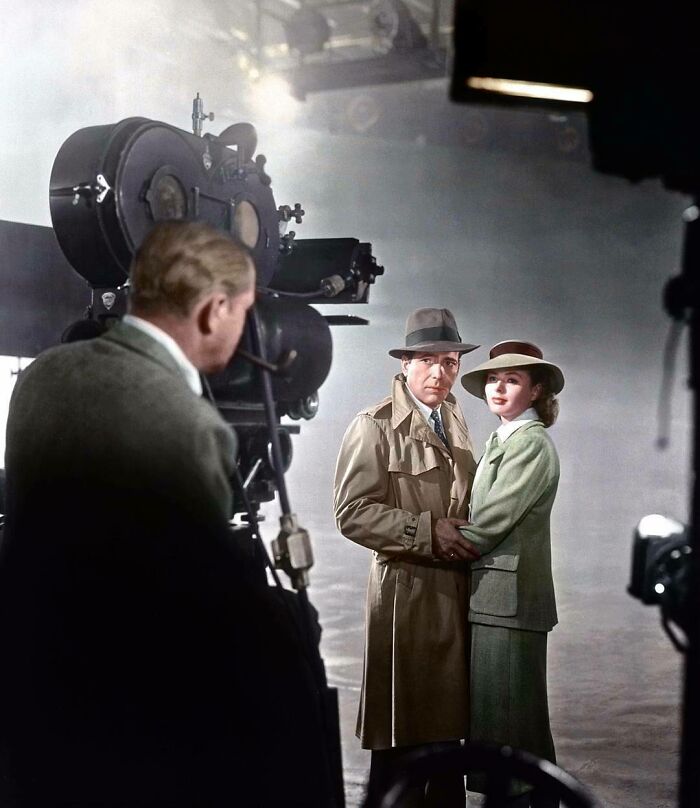
Image credits: cassowarycolorizations
#41
Periscope use in a French first line trench, 1915. The “French are cowards concerning military and always surrender” myth was not originated in WWI, as some may believe, but inevitably after the German invasion of 1940 and the later instalment of the puppet state of Vichy. During WWII, not only the French did generally show extremely courage and bravery, fighting in their colonies, and even penetrating in German soil in 1939, but also had a long history of victories on Europe. The myth, mainly propagated with bad intention by the U.S. died during the 50s. Sadly, in the last years, the myth is being used again, not only on a pure humorous way, but as a critical and harmful accusation in relation on the resurgence of France refusing to back Bush's war effort in Iraq.

Image credits: cassowarycolorizations
#42
A member of the French Forces of the Interior, the French Resistance, uses a truck for cover during the Liberation of Dreux, France, August 1944. I’ve just finished the book ‘Fighters in the Shadows’, by Robert Gildea, one of the best and bravest depictions of the French Resistance I’ve ever read. Gildea brilliantly explains the truth behind the French Resistance myth, and how De Gaulle helped to shape the legend of firm opposition to Nazism from the outset, and the fact that French freed themselves. “Paris liberated! Liberated by its own efforts, liberated by its people with the help of the armies of France, with the help of all of France”, said on a meeting the French general. The book, although being written with incredibly criticism, does not blame in any moment those who suffered from the Nazi regime, but tries to explain in detail what really was the French resistance. A highly recommended reading, no doubt. 08/1944

Image credits: cassowarycolorizations
#43
Waffen SS privates from the 5th SS Panzer Division firing several Luger P08 during winter training. The Pistole Parabellum 1908, widely known as the Luger P08 was a semi-automatic pistol first designed by Georg J. Luger in 1898 and was first used by the Swiss army in May 1900, although it was later used in greater scale by Germany during World War I and World War II, along with the interwar Weimar Republic and the postwar East German Volkspolizei, stopping its production in 1942, when the Walther P38 entering in production in 1938. The cost of a Luger was of $13 or 32 RM (approximately $200 or 500 RM adjusting inflation) Because of its association with Nazi Germany, the pistol has been used in fictional works by many villainous characters over the past several decades.

Image credits: cassowarycolorizations
#44
Rebel soldiers aiming in trenches near Navacerrada during the first winter of the Spanish Civil War, Sierra de Guadarrama, December 1936. The Sierra of Guadarrama or Guadarrama Range was a common battlefield in the first stages of the War, and a great example of how geography can shape the outcome of a war. After the coup of the Fascist generals, rebel General Mola developed a plan to assault Madrid, the capital, by raiding the city from the North. The heights prevented the Rebel troops from crossing, an in August they lost the battle. If Madrid hadn’t been situated in a plateau, the war could have been won by the Francoist troops before 1937.

Image credits: cassowarycolorizations
#45
My favourite colourisation I’ve ever done, and I must thank ww2_forgotten_history for sending it to me. It depicts a French Resistance member during the Liberation of Paris, 23th August 1944. We have been searching the actual location trough Facebook, through our beloved WW2 Colourised Photos page, where it was featured. Lots of people helped us to try to solve that mystery, but we still couldn’t find it.
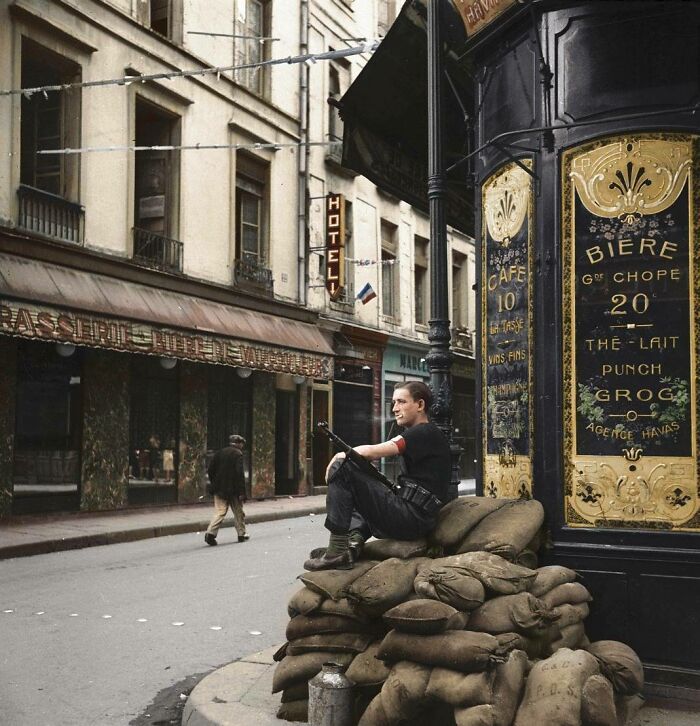
Image credits: cassowarycolorizations
#46
Brewster F2A Buffalo in the Finnish Air Force.

Image credits: cassowarycolorizations
#47
Soldier of the Polish People’s Army on training wearing a gas mask with its emblem worn in the ushanka hat. This colourised version is now the profile picture of @historians_union_main. Although I can’t say nothing more about the picture, the Polish People's Army, or, in Polish, Ludowe Wojsko Polskie, was the second formation of the Polish Armed Forces in the East and later the armed forces of the Polish communist government of Poland, which from 1952, was known as the Polish People's Republic along with the ruling Polish United Workers' Party. This military unit was formed during the Second World War as the Polish 1st Tadeusz Kościuszko Infantry Division, also known as the Berling Army. Its prestige, however, started to fall during the post-war, eventually disappearing in 1989.

Image credits: cassowarycolorizations
#48
Hundreds of Willys MB aka @jeep and trucks provided by the U.S. to the British from the 9 HQ. The Willys MB, formally as the U.S. Army Truck, 1/4 ton, 4x4 and the Ford GPW are four-wheel drive utility vehicles that were manufactured during World War II. Produced from 1941 to 1945, it evolved post-war into the civilian Jeep CJ, and inspired both an entire category of recreational 4WDs and several generations of military light utility vehicles. 359,489 MB were produced, as well as 277,896 GPW.

Image credits: cassowarycolorizations
#49
Two women and what seems to be an Assault Guard during the Siege of the Alcázar, in Toledo, during Spanish Civil War. The role of women during the Spanish Civil War was very different between sides. During the years of the 2nd Republic (1931-1939), women started to gain freedom, strictly censored by the dictatorship of Primo de Rivera (1923-1930), and in 1931 women’s right to vote was approved. During the war, in the Republican side, women reached the biggest ladder of liberties, and eventually saw themselves standing in the battlefield among men. On the other hand, in the Nationalist side, women were strictly prohibited from bearing arms, and their task was relieved to nursing. Later, during Franco’s dictatorship (1939-1975), the so called government made up a plan where woman where supposed to fulfil the role of wife, mother and housewife, with single-sex school policy. The women had to wear long and little scandalous clothes, with a censorship present in the media and especially the cinema, stepping 40 years back. Pilar Primo de Rivera, member of the Falange, said once: “Let's be nice and funny little ants”. 1936
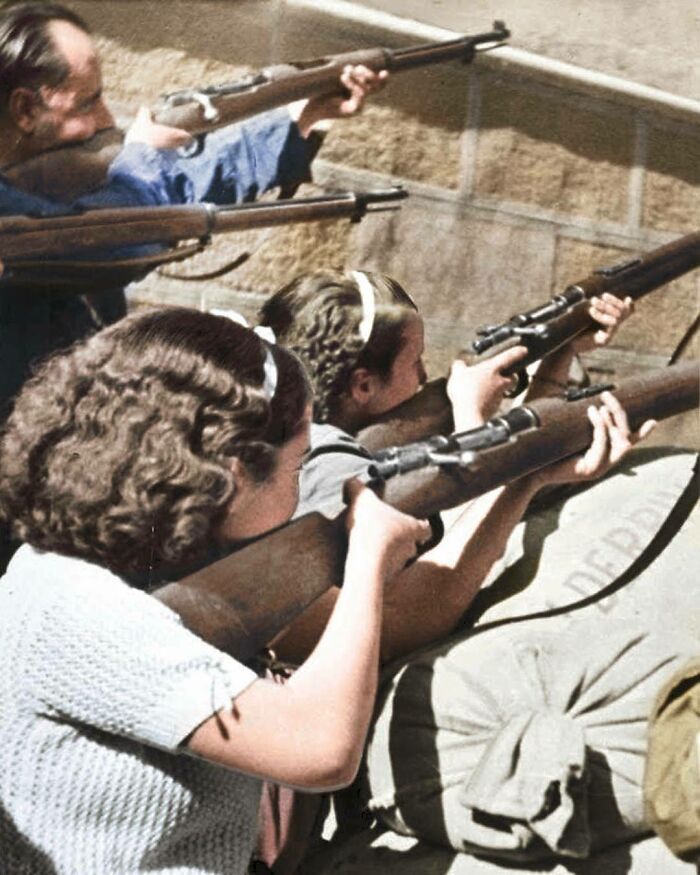
Image credits: cassowarycolorizations
#50
Can you guess the army and the year? Infantry pushing through enemy barbed wire. While originally invented to restrain cattle in Ohio, barbed wire played a pivotal role in shaping the new ways of fighting that emerged during the First World War. Preventing any kind of unified infantry charge, wire was used as a defense of the now universal trench static system. It was not until the invention of the tank that barbed wire defenses could be overcome in an effective way.

Image credits: cassowarycolorizations
#51
Captain D. Michelson with Tim the tortoise, the pet of the Australian 2/2nd Battalion, 16th Brigade, 6th Division, Julis, Palestine, 28 March 1930. So I was curious about Captain Michelson, but couldn’t find anything about his service in WWII. The Australian War Memorial didn’t through any clues, until I searched just the surname and, hidden in a group picture, I found his complete name: David Enoch Michelson, SN - NX320, was born in Sydney (the 2/2nd recruitment area was NSW) on April 19, 1910. Enlisting in Denistone on December 27, 1939 was discharged six years later, on October 9, 1945. You can find several recordings and interviews of him in the Australian War Memorial website.
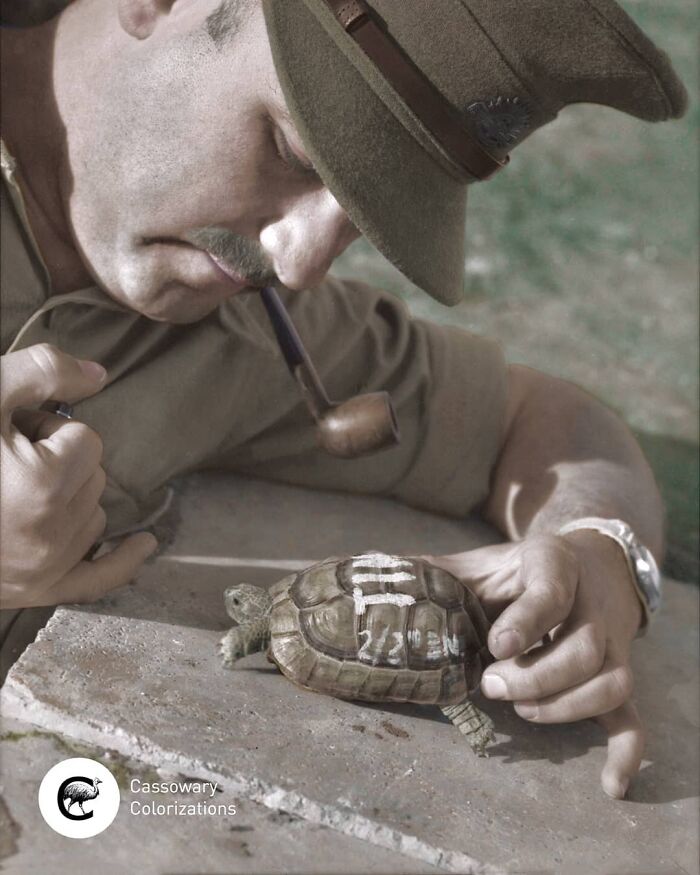
Image credits: cassowarycolorizations
#52
Comparison between a British WWI veteran soldier armed with a rifle with a soldier in a full suit of medieval armour handling an axe, October 1917. This interesting picture just represents the evolution of plate armour. European plate armour reached its peak in the late 15th and early 16th centuries, so we technically shouldn’t always call it ‘Medieval’. Plate armour saw a decline during the 17th century, where warfare became very close to gunpowder weapons techniques. During the 19th and the beginning of the 20th century however, plate armour saw a little revival due to the introduction of shrapnel in modern warfare.

Image credits: cassowarycolorizations
#53
Soldiers of the Red Army waive the Soviet Union flag somewhere in Berlin, May 3, 1945. The flag of the Union of Soviet Socialist Republics; usually shortened was USSR, and also known as “The Hammer and Sickle” and “The Red Banner”, was the official national flag of the Soviet Union from 1923, when it was chosen in the Third Session of the Executive Committee, to 1991, with the dissolution of the Soviet Union. The flag's design and symbolism are directly derived from the Russian Revolution, and therefore it’s a symbol of the communist movement. The red flag was a traditional revolutionary symbol used in the French revolutions of the 19th century and had a very strong symbolism. The icons represented the union of the workers (hammer) and the peasants (sickle). The gold-bordered red star representing the Communist Party of the Soviet Union.

Image credits: cassowarycolorizations
#54
Two soldiers comfort each other under the strain of combat in Pleiku, South Vietnam, 26 May 1967. Pleiku was strategically important during the Vietnam War because it was the primary terminus of the military supply logistics corridor extending westwards along Highway 19 from the coastal population centre and port facilities of Qui Nhơn. Additionally, its central location on the plateau, between Kon Tum in the north, Buôn Ma Thuột to the south, and the North Vietnamese Army's base areas inside Cambodia to the west made Pleiku the main center of defense of the entire highland region of the Republic of Vietnam. This was obvious to both sides; the United States established an armed presence very early in the conflict at Camp Holloway, and the Việt Cộng attack on this base in early 1965 was one of the key escalating events that brought U.S. troops into the conflict. On 15 June 1972, Cathay Pacific Flight 700Z, operating a Convair 880 from Bangkok to Hong Kong, disintegrated and crashed while the aircraft was flying at 8,800 m. over Pleiku, Vietnam after a bomb exploded in a suitcase placed under a seat in the cabin, killing all 81 people on board.
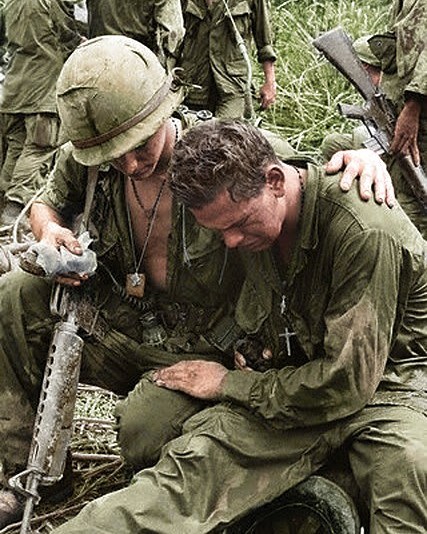
Image credits: cassowarycolorizations
#55
First part of Finland series: The Winter War Finnish Soldiers during the Winter War using a slingshot to lob grenades at the Soviets. The Winter War began with the Soviet invasion of Finland on 30 November 1939. This attack was considered illegal for The League of Nations and therefore, the Soviet Union was expelled from the League. The Soviet Union, which had before claimed sovereignty on some areas of Finnish territory, demanded concessions of several lands in the Leningrad area claiming security reasons. Finland refused and the USSR invaded the country. Numerically superior, the Soviets, though the whole invasion of Finland would be an easy job. Nevertheless, the Finnish forces repelled Soviet attacks for several months, far much longer than the Soviets expected. Hostilities ceased in March 1940 with the signing of the Moscow Peace Treaty, as the Red Army had been gaining land and Finland ceded territory representing 11% of its land area and 13% of its economy. The poor performance of the Red Army encouraged Hitler to think that an attack on the Soviet Union would be successful and reconfirmed negative Western opinions of Soviet military. 25,904 Finnish soldiers perished in the war, in front of c. 140,000 Soviets.

Image credits: cassowarycolorizations
#56
A Norwegian child being carried to an ambulance from HMS Onslaught at Gourock, Scotland, 1 March 1945. She was one of over 500 civilians recued by the Royal Navy after hiding from the Germans on Sørøya island. 525 Norwegians, who had been hiding from German patrols in caves on the snow covered mountains of Sørøya island, Norway for three months, were rescued by four British destroyers of the Home Fleet who raced in broad daylight, 60 miles behind enemy lines and took them safely to a Gourock.
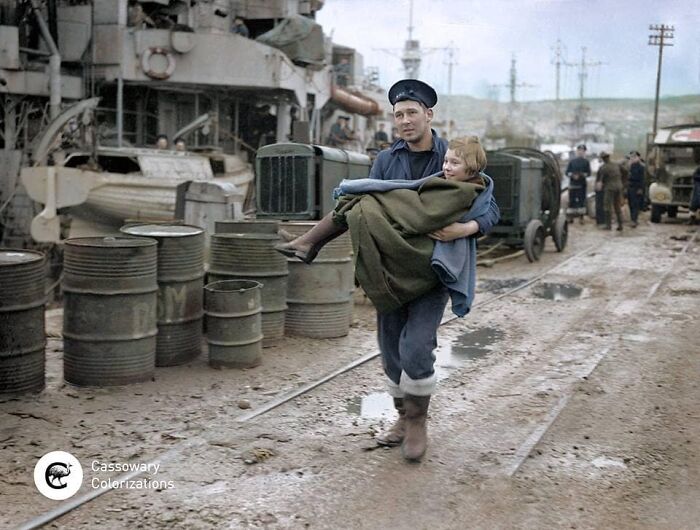
Image credits: cassowarycolorizations
#57
Bomber “Marauder” B-26, serial number 43-34565, Gratis Gladys, 7I-B, 497 Squadron, 344th Bombardment Group, 9th U.S. Air Force is crashing to the ground after receiving a direct hit in the left engine during the bombing of Erkelenz, Germany, 23 Feb 1945. The discovery of the serial number and unit of this plane was a hard job. Once I gathered all the sources, I uploaded all the information to @imperialwarmuseums ‘s American Air Museum in Britain. The Gratis Gladys was declared Failed to Return 23 February 1945 during a bombing mission to Erkelenz. After receiving flak explosions in its left flank, the plane crashed, killing all the crew, Pilot Capt. Carl Franklin Chapman, Co-Pilot 1st Lt John Jack Sheehan, Bomb. 2nd Lt James Richard Harl, Nav. 1st Lt. Kenneth Gordon, Radio/Gun T/Sgt. J P Herndon, Eng/Turret S/Sgt Ballard James Bentley, and Tail/Armor S/Sgt. W T Williamson.

Image credits: cassowarycolorizations
#58
The Lapland War Finnish sappers training with a captured soviet ROKS-2 flamethrower during an exercise in Aunus, Karelia, Finland, March 1943. The Lapland War was the last intervention of Finland in the Second World War. I was not fought against the Soviets, as the Winter and Continuation War, but fought against Germany from September 1944 to April 1945 in Finland's northernmost Lapland Province. For the German, the retreat through Lapland was part of the Second World War as part of their two campaigns to evacuate northern Finland and northern Norway, which would derive in Operation Birke and Operation Nordlicht. The Finnish Army was required to demobilise their forces by the Russians, who had ordered through the Moscow Armistice, but also attack the Werhmacht in the northern areas. Eventually, German forces retreated to Norway. However, Finland would suffer an awful post-war situation, with more than 100,000 inhabitants becoming refugees and an irreparable debt. Casualties were not as heavy as before, with just 774 Finnish soldiers perishing in the war, in front of c. 1,000 Germans.

Image credits: cassowarycolorizations
#59
The Continuation War Finnish soldier using a NBC suit and a Nazi helmet, somewhere in the woods of Finland. The Continuation War, lead after the Winter War, lasted from 1941 to 1944. Germany found a great opportunity of fighting the USSR after having launched the Operation Barbarossa, and suddenly decided to provide Finland with critical material support and military cooperation. The first to attack were, nevertheless, the Soviets, with an air offensive to Finland on 25 June. Subsequent Finnish operations undid its post-Winter War concessions to the Soviet Union on the Karelian Isthmus and Ladoga Karelia, and captured East Karelia by September 1941. The Finns halted their offensive 30 km from Leningrad, regaining all the land lost in the previous years. Finnish forces did not participate in the siege of Leningrad directly, they decided to instead protect their borders at all cost, engaging in several air fights against the Russians. During this air campaigns, Soviet air forces began conducting air raids over Helsinki and other major Finnish cities. Eventually, in mid-1944, the Soviet strategic offensive drove the Finns from most of the territories they had gained during the war, but the Finnish Army later brought the offensive to a standstill in July 1944. A ceasefire ended hostilities on 5 September and was followed by the Moscow Armistice on 19 September. 70,000 Finnish and German soldiers perished in the war, in front of c. 305,000 Soviets.

Image credits: cassowarycolorizations
#60
A Russian partisan carrying several weapons. In the right hand, he’s holding a PPSH-41, while in his belt he’s using a RGD-33 grenade, a RPG-40 anti-tank grenade, three F1 grenades, a German Stielhandgranate 24, a belt of 7.62 ammunition and 2 M1895 Nagant pistols. He is, ironically, holding nothing on the left hand. 1944

Image credits: cassowarycolorizations
#61
A sign erected by a man form Dog Company during the Korean War, 25th March 1952, Korea. Maybe taken after the Battle of Maehwa-San, or during the Fourth Battle of Seoul, this picture is just one of many similar that spread during WWI, WWII, the Korean War, and the Vietnam War. This is my fastest colorization, 12 minutes. It’s not a good colorization, but I wanted to test new techniques with this one, to make it look like an 80s photo.
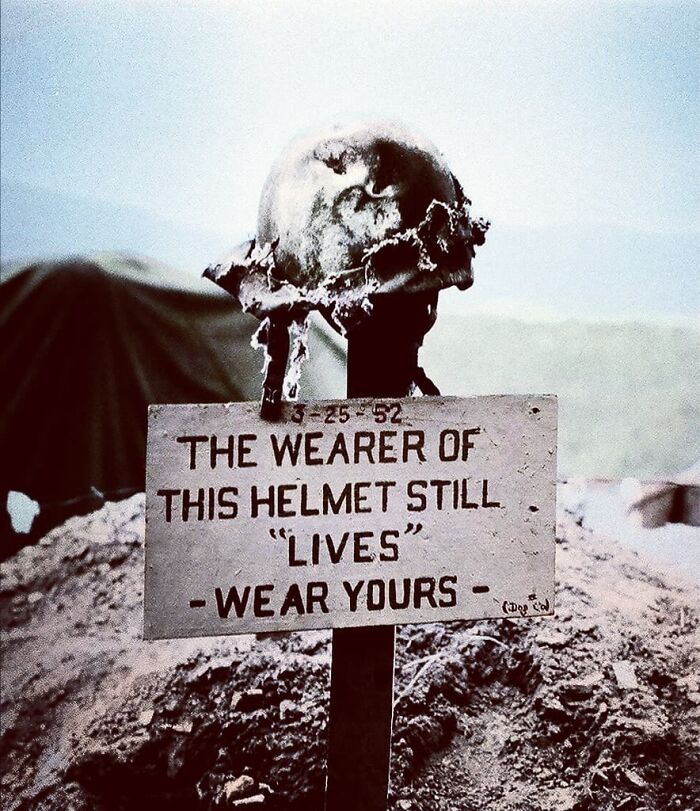
Image credits: cassowarycolorizations
#62
German Luftwaffe machine operators using an anti-aircraft MG-15 gun next to an airfield. The Luftwaffe used blue as its basic colour, with a uniform consisted of a blue-grey single-breasted, open-collared jacket with four pockets and flaps, white shirt and black necktie, blue-grey trousers, black leather boots and a blue-grey peaked cap, side cap or Model 1935 Stahlhelm. While on field service the jacket would often be worn 'collared up', without shirt or tie. This was applied to AA soldiers and field forces. The flying suit, however, typically consisted of a beige jumpsuit.

Image credits: cassowarycolorizations
#63
The Schwerer Gustav was a railway gun, the largest-calibre rifled weapon used in combat, the heaviest mobile artillery piece built in terms of overall weight, and that which fired the heaviest shells of any artillery piece. It was developed in the late 1930s by Krupp in Darłowo as siege artillery for the purpose of destroying the main forts of the French Maginot Line. Gustav was deployed in the Soviet Union after the Battle of France, where it didn’t see action, where it destroyed a munitions depot. The gun was moved to Leningrad, and may have been intended to be used in the Warsaw Uprising. Gustav was destroyed by the Germans near the end of the war in 1945 to avoid capture by the Red Army.

Image credits: cassowarycolorizations
#64
French soldier with a medic (according to the badge) steel helmet covered with a built-on chain screen to protect a soldier's eyes from rocks, shells and other fragments created by E. J. Codd Company of Baltimore, Maryland, 1918. This Adrian helmet can be identified as a medic one thanks to the badge on the front. The most common badges on Adrian helmets were the infantry and artillery ones, although others such medical, cavalry, and colonial corps also existed. Those Adrian helmets used by other countries like Russia, the U.S., Italy, or Belgium had also distinctive badges. What’s your favourite? Mine are the Russian ones.

Image credits: cassowarycolorizations
#65
Adolf Hitler hands General Erwin Rommel his Oak Leaves to the Knight's Cross of the Iron Cross, Berlin, 20 February 1941. The excess of contemporary admiration torwards Rommel and his depiction as apolitical and critical to the III Reich is known as "Rommel myth". The myth is, however, not contemporary, as it was created as early as 1941, in order to justify the Allied faliure in North Africa, praising Rommel's role instead of accepting a defeat. After the war, the Allied Staff depicted Rommel as a good German but not Nazi soldier -'our friend Rommel'-, in an anticipation to the "Clean Wehrmacht myth". These falacies were used by West German in order to rearm during the Cold War. Nowadays, Rommel is still a hard figure to sort out, but his relations with National-Socialism are indisputable.

Image credits: cassowarycolorizations
#66
A native Papuan soldier holding a Mk. VII Bren receives militia training by Australian forces in Oro Province, Papua New Guinea, 15 July 1943. 45,000 indigenous people of New Guinea and Papua were conscripted into the Australian army to work as stretcher bearers. Called 'Fuzzy Wuzzies' because of their characteristic frizzy hair, they became a welcome sight for the embattled Australian soldiers on the Trail. ------- IMPORTANT: I am deeply keen on the Australian campaign over Papua and New Guinea, especially New Britain. If you have any militaria, item, or photographs of this period, please contact me or let me know in the comments. 15/07/1943

Image credits: cassowarycolorizations
#67
An exclusive picture from the book ‘1915-1918 The Great War in color - Italian & Austrian front’, in which I collaborated with @soldiershoppublishing. It depicts an Austrian infantryman with a great plate armour covering his whole body, in 1915. Plate armours, Sappenpanzer in German, were tested from the beginning of the war, but they started to get introduced to wider squads in 1916. The equipment weighed between 9kg and 12kg, with 500,000 sets being issued to men on the Western Front. Capable of stopping low velocity fragments and shrapnel, the Sappenpanzer was, due to its weight, only practical for troops on sentry duty and machine gunners operating in static positions, contrary to the popular believe (ehem, Battlefield 1, ehem) in which these armours would have been used to attack or raid trenches. They were usually designed in order to be used together with the armoured brow plate that hooked on to the steel helmet.

Image credits: cassowarycolorizations
#68
A Frenchman offers a glass of wine to an Ameirican heavy gunner near Coutances, France, July 1944. Operation Cobra was the offensive carried out by the First United States Army under Omar Bradley a month and a half after the D-Day landings. The strategy was based in creating corridor had been created and advance into Brittany. After heavy bombardments in, for instance, the place this picture was taken forced the German resistance to collapse, making it easy for U.S. swift manoeuvres.

Image credits: cassowarycolorizations
#69
Erwin Johannes Eugen Rommel was one of the most famous German field marshals during World War II. He was nicknamed the Desert Fox (Wüstenfuchs) following his ability as commander of the Afrika Korps during the North African campaign between 1941 and 1943. He later received command of the German units stationed in France to contain the foreseeable allied invasion, which eventually materialized in Normandy. Rommel is frequently remembered not only for his marked military prowess, but for his chivalry with his opponents (he was one of the German commanders who refused to obey the Kommandobefehl). After the attack of 20 of July of 1944 against Adolf Hitler, was accused of having participated in the same and forced to commit suicide to avoid reprisals against his family and his near personnel. However, it’s has always been an ambiguous and polemical figure, since it’s disputed by Historians whether he was actually an apolitical figure or a propaganda figure used by the Allies that has survived until nowadays. 1942

Image credits: cassowarycolorizations
#70
Today it marks 99 years since World War I finished. WWI was a war lost by both sides. The Aliance would lose many of its territories, countries disappeared, and the Treaty of Versailles would lead to a hideous humiliation. That’s where the Entente did also lose; the consequences of the Treaty of Versailles would directly lead them to WW2. They also failed, of course, in accomplishing the “War to end all wars”. Caption: German soldiers with camouflage helmets help wounded Belgian troops somewhere in the Western Front, c. 1918. This is not an official caption, and I was unable to find the real one or to check if they are actually Belgians. Can you help me?

Image credits: cassowarycolorizations
#71
Austrian Schwarzlose machine gun mountain unit between Monte Cevedale and the Gran Zebrù, Northern Italy, 1917. The Italian Front, known in German as the Gebirgskrieg ("Mountain war"), was the front that saw hostilities between Austria-Hungary and Italy during World War I. After secret promises made in the Treaty of London, Italy entered the war to take Austria-Hungary southern territories. This manoeuvre was intended to be fast and to take the Austrians at another front. The Austrians, however, answered the offensive with trench warfare and gained terrain into Italy, eventually being defeated when general Díaz took command over general Cadorna and pushed over the Veneto.

Image credits: cassowarycolorizations
#72
Soldiers from the Indian Legion being inspected by Luftwaffe officers, Bordeaux, France, February 1944. The Free India Legion, officially the Infantry Regiment 950 (Indian), and later the Indian Volunteer Legion of the Waffen-SS intended to serve as a liberation force for British-ruled India, it was made up of Indian prisoners of war and expatriates in Europe. Initially raised as part of the Heer, it was part of the Waffen-SS from August 1944. A maximum of 2,600 Indians joined or were drafted into the legion. The Indians fought on France, Italy, and In January 1942, 100 men from the unit were parachuted into Persia and infiltrated India to commit sabotage. 02/1944

Image credits: cassowarycolorizations
#73
Again, I’m very sorry, but I’ve been very busy with something spectacular that I will share soon with you. So I post this amazing picture that @ww2_forgotten_history asked me to colorize. I will recommend you to follow him to get the other cheek of the war. The caption is his: “Danish resistance members inside a truck, Odense, Denmark, 1945. In theory, Denmark was not officially at war with Germany (though clearly Denmark had been illegaly occupied by the Germans in 1940) as the government had not declared war on Germany. Though the government accepted as a fait accompli that Denmark had been occupied, many Danes did not. Many Danes were involved in underground activities, the production of illegal publications, spying, sabotage, non-cooperation, hiding crashed pilots, battling against Germans, providing key intelligence to the Allies...”

Image credits: cassowarycolorizations
#74
German Luftwaffe machine operators using an anti-aircraft MG-15 gun next to an airfield. The Luftwaffe used blue as its basic colour, with a uniform consisted of a blue-grey single-breasted, open-collared jacket with four pockets and flaps, white shirt and black necktie, blue-grey trousers, black leather boots and a blue-grey peaked cap, side cap or Model 1935 Stahlhelm. While on field service the jacket would often be worn 'collared up', without shirt or tie. This was applied to AA soldiers and field forces. The flying suit, however, typically consisted of a beige jumpsuit.

Image credits: cassowarycolorizations
#75
Luftwaffe (German Air Force) corporal at the entrance to the former headquarters of the Royal Air Force on the island of Guernsey, 1941. The Luftwaffe was the first branch to occupy Guernsey, since after a reconnaissance pilot made a test landing in the deserted airfield, he realised the island was not defended. The same day a platoon of Luftwaffe airmen was sent to invade the island. Today the German Occupation Museum in Guernsey can be visited.

Image credits: cassowarycolorizations
#76
A British Home Guard inspecting a Messerschmitt Bf from the 7. Staffel, Jagdgeschwader 54 in Kent, 27 October 1940, during the Battle of Britain. A Staffel, singular for Staffeln, was a unit formation within the Luftwaffe that counted with nine to twelve aircrafts. It was seen as more or less an equivalent of a British or American squadron. This made that Allied leaders overestimated German air power, believing they were facing squadrons, while the reality was that they were facing smaller numbers.

Image credits: cassowarycolorizations
#77
Japanese Special Naval Landing Forces holding a position behind the corner of a building with a Type 11 light machine gun, equipped with Type 99 gas masks, in Shanghai, China, August-November 1937. The Special Naval Landing Forces were the marine troops of the Imperial Japanese Navy. Initially, the SNLF were not a marine force, but was instead sailors who had basic infantry training and were employed in landings during the Russo-Japanese War and the Boxer Rebellion. The unit was formed in 1928 and saw extensive service in the Second Sino-Japanese War and the Pacific theatre of WW2. The Battle of Shanghai was the first of the twenty-two major engagements fought between the National Revolutionary Army (Chinese nationalists) and the Japanese Army during the Second Sino-Japanese War, it was one of the largest and bloodiest battles of the Second Sino-Japanese War.

Image credits: cassowarycolorizations
#78
Free French forces with 2e Escadron, 12e régiment de chasseurs d'Afrique, 2e Division Blindée, ready their M4 Sherman tanks waiting to join U.S. Major General Walton Walker during the Battle of Normandy in Vesly, Normandy August 6, 1944. The second tank is M4A2 Sherman "Tarentaise" (28) which was destroyed at Rouessé-Fontaine (Sarthe) on August 12, 1944. The tank was hit by several shots and caught fire. The crew managed to evacuate, and the Chief: Marshal of Logis Bizard, was wounded. M4A2 "Maurienne" (29) - also of the 2nd Squadron was destroyed, on January 3, 1945. 06/08/1944

Image credits: cassowarycolorizations
#79
Richard Bochalli (1848-1922) in Prussian uniform after being reactivated at the age of 67 to set up and run three prison camps in northern Germany. Noticeable decorations are, from left to right, the Iron Cross, the Order of the Red Eagle, the Order of the Crown, the Prussian Twelve Years Army Service Medal, the War Commemorative Medal of 1870/71, and the Centenary Medal. Richard Bochalli was born the 2nd April 1848 in Neisse and died shortly after the war, the 7th July 1922 in Lostau. He had two sons and two daughters. Bochalli, after being reactivated in 1915, run three prison camps in Germany: Ahlen-Falkenberger Moor (near Westerwanna), Haaßel (near Selsingen), and Königsmoor (Harburg district); Bochalli took many pictures of these camps.

Image credits: cassowarycolorizations
#80
A Marine in shock with a thousand-yard stare waiting to be evacuated from the battle zone. Hue, Vietnam, 1968. The thousand-yard stare is a phrase coined to describe the limp, blank, unfocused gaze of a battle-weary soldier. A characteristic of shell shock, the despondent stare reflects dissociation from trauma. The thousand-yard stare is thus often seen in cases of incipient post-traumatic stress disorder. The phrase was popularized after Life magazine published the painting “Marines Call It That 2,000 Yard Stare” by World War II artist and correspondent Tom Lea, although the painting was not referred to with that title in the 1945 magazine article. The painting, is now held by the United States Army Center of Military History. 1968, Don McCullin

Image credits: cassowarycolorizations
#81
A wrecked Kawasaki Ki-61 being inspected by 2/2nd Australian Infantry Battalion privates Baker and McCudden in Dagua Airfield, New Guinea, 1945. The Kawasaki Ki-61 Hien (which means “lying swallow” in Japanese) was a Japanese fighter introduced in 1942. Allied pilots initially believed Ki-61s were Messerschmitt Bf 109s, and eventually Italian aircraft, and therefore they started to call them "Tony"s. 3,078 Ki-61s were produced, some of them used by the Chinese after the war. 25/03/1945

Image credits: cassowarycolorizations
#82
75 years ago today, soldiers of the 250th Infantry Blue Division march through a route near the village of Krasny Bor, Leningrad Region, January-February 1943. The Battle of Krasny Bor was part of a large Russian offensive against German positions, which intended to create pincer attack near Leningrad, releasing the siege and encircling the German 18th Army, which would have had to surrender. The first day of the battle was a success for the Soviet troops, but the Francoist forces from the Blue Division, reinforced with an SS Police Division could dig in, losing over 70% of their members. Russian casualties were, however, higher, with more than 20,000 casualties, including wounded. The 13th, observing that it would be useless to attack the sector, the Soviets decided to cease the offensive.

Image credits: cassowarycolorizations
#83
Royal Flying Corps pilot cadet practicing deflection shooting from a moving platform installed on rails and launched at high speed, probably Egypt or Palestine, during World War One. The Royal Flying Corps (RFC) was the air branch of the British Army before and during World War One, until 1918, when the Royal Naval Air Service and the RFC united to form the RAF. During the first months of war, the RFC supported the British Army by artillery co-operation and photographic reconnaissance. As the enemy was doing the same, it gradually led RFC pilots into aerial battles with German pilots and later in the war included the strafing of enemy infantry and emplacements, several bombings of German cities, airfields and factories. In 1914, the RFC had approximately 2,000 personnel, five years later, the RAF had 114,000 personnel in service distributed in 150 squadrons.

Image credits: cassowarycolorizations
#84
Indian Sikh soldier with Lee–Enfield and sword in a photo studio, 1914. One million Indian soldiers, mainly Sikh warriors, served under the yoke of the British Empire overseas, eventually counting 120,000 casualties in 1918. The Indian Army did not only fight the German Empire and the Ottoman Empire in Africa, but also on the trenches of the Western Front. At the First Battle of Ypres, Khudadad Khan became the first Indian to be awarded a Victoria Cross.

Image credits: cassowarycolorizations
#85
EXCERSICES BEFORE THE INVASION, 1940 A British lieutenant briefs his section leaders (note a 2nd lieutenant at his right) during an exercise in the snow by troops of the 1/7th Battalion, Warwickshire Regiment, between Douai and Orchies, taken by Captain Leonard 'Len' Arthur Puttnam, 26 January 1940. The 1/7th Battalion had just arrived in France in time to join the British Expeditionary Force, which was assigned the task of reinforcing French units and stopping any attempt of German advance. It seems the Company H.Q. was established in the Forest of Flines, near Douai (1). In May, German and British forces clashed in the Ypres-Comines Canal, near the French-Belgian border, south of Dunkirk (2). By the end of the month, only 15 officers and 200 soldiers were left, being ordered to retreat north to Dunkirk, where they were repatriated back to England. Their actions in Belgium were essential to delay the German advance and secure the withdrawal of the BEF. All men in the picture are unnamed. The very same day the photograph was taken, Brisbane registered its hottest day ever, at 43.2 °C.

Image credits: cassowarycolorizations
#86
An Italian M13/40 tank captured by the 6th Australian Division in Libya, 4 March 1941. The 6th Division was an infantry division of the Australian Army. It was raised briefly in 1917 during World War I, but was broken up to provide reinforcements before seeing action. It was not reraised until the outbreak of World War II, when it was formed as a unit of the Second Australian Imperial Force. Throughout 1940–1941 it served in the North African Campaign, the Greek campaign, on Crete and in Syria, fighting against the Germans, Italians and Vichy French. In 1942, the division left the Middle East and returned to Australia to meet the threat of Japan's entry into the war. Part of the division garrisoned Ceylon for a short period of time, before the division was committed to the New Guinea campaign. In New Guinea, its component brigades had a major role in the successful counter-offensive along the Kokoda Track, one of the most significative battles in Australian history, but also at Buna–Gona and around Salamaua–Lae in 1942–1943. Throughout late 1943–1944, the division was reorganised in Australia before being committed as a complete formation to one of the last Australian operations of the war around Aitape–Wewak, in the Pacific, in 1944–1945.

Image credits: cassowarycolorizations
#87
A soldier from the New Zealand Division overlooking a group of German POW's during the Second Battle of El Alamein, November 1942. According to historians Niall Ferguson and Keith Lowe, German POWs held by British and Commonwealth countries, only had a 0.03% percentage of casualties. German and Japanese POW camps could raise that number to a 33% and even to a 57.5% in camps bound to Soviets. One of the most infamous treatment to POWs happened in the Philippines, where the events carried out by the Japanese in 9 April 1942 are known as the Bataan Death March. Exact casualties are unknown. Estimates range from 5,650 to 18,000 POW deaths killed by fatigue, severe physical abuse and wanton killings.

Image credits: cassowarycolorizations
#88
0 years ago, German soldiers and 'Landespolizisten' (border police) of the Free City of Danzig remove the Polish border crossing in Sopot, September 14, 1939, as a reenacment of the same event on September 1. The day the invasion began, resistance was offered by the Polish 2nd Maritime Rifle Regiment in the crossing at Sopot. The following weeks of suffering would become months and eventually years as a new kind of war turned to evolve in one of the cruelest events in Human history.

Image credits: cassowarycolorizations
#89
Today is the 73rd Anniversary of the Warsow Uprising. This operation was a major World War II action directed by the Polish resistance Home Army to liberate Warsaw from German occupation in the summer of 1944, along with the Soviet Union's Red Army approaching the eastern suburbs. The Germans gained time and demolished the city while defeating the Polish resistance, with little outside support. The uprising ended with 150,000–200,000 civilians killed, and 700,000 expelled from the city. Most of the pictures we have come from Eugeniusz Zenon Lokajski, a young Polish athlete, gymnast and photographer., with more than 1000 photos documenting the Warsaw Uprising, where he finally was killing in action.

Image credits: cassowarycolorizations
#90
An Italian Alpini looks at the front somewhere in the mountain coves of the Austrian Front, c. 1917. The Alpini were and are an elite mountain subdivision of the Italian Army. The first Alpini appeared in 1872, therefore being the oldest active mountain infantry in the world. Their original mission was to protect Italy's northern mountain border with France and Austria, which was exactly what they did after the breaking of World War I, as they fought a three-year campaign on the Alps against Austro-Hungarian Kaiserjäger and the German Alpenkorps in what has since become known as the "War in snow and ice". In this kind of warfare, whoever occupied the higher ground first was almost impossible to dislodge, so both sides turned to drilling tunnels under mountain peaks, filling them up with explosives and then detonating the whole mountain to pieces, including its defenders. The remains of these soldiers are still being uncovered today.

Image credits: cassowarycolorizations
#91
Happy Italy's Liberation Day! A column of Italian partisans, with its flag bearer in the front, crossing the Alps during the Italian Civil War, c. 1944. The Festa della liberazione is a national Italian holiday commemorating the end of the Italian Civil War and the end of the subsequent Nazi occupation. The Civil War lasted nearly three years and saw forces loyal to Mussolini's dictatorship, supported by the Nazi occupation, against the forces reluctant to the Fascist regime, who supported an armistice with the Allies.

Image credits: cassowarycolorizations
#92
British Vickers machine gun crew wearing PH-type anti-gas helmets. Near Ovillers during the Battle of the Somme, July 1916. The gunner is wearing a padded waistcoat, enabling him to carry the machine gun barrel. Gas masks were created with the aim of protecting soldiers and civilians from inhalation not only toxic gases, but also harmful air particles. Gas masks have different filters, which usually last 24 hours, selected according to the toxic compound, protecting against a particular hazard (e.g. sulphurs, CO2, mercury, etc.). Although during Ancient Greece, Greeks used “sponges as gas masks”, the first modern usage was a response in WWI against gas warfare. Some British chemists had investigated them before, but the first use of poison gas on the Western Front was on 22 April 1915, which lead to a quick intervention of both British and German Empire to develop a more efficient mask to protect their men. 07/1916, John Warwick Brooke (IWM)

Image credits: cassowarycolorizations
#93
Tiger Is moving through the fields of Kursk during the battle, July 1943. Kursk is probably one of the greatest point-turn battles of modern history, with many aspects sometimes forgotten. For example, the Battle of Kursk implied the introduction of the new Tiger, or the Panther; as well as new aircraft, as Kursk was also an air battle. Before the fatal engagement, German general Heinz Guderian opposed the operation, asking Hitler: “Is it really necessary to attack Kursk, and indeed in the east this year at all? Do you think anyone even knows where Kursk is? The entire world doesn't care if we capture Kursk or not. What is the reason that is forcing us to attack this year on Kursk, or even more, on the Eastern Front?”.

Image credits: cassowarycolorizations
#94
Gavrilo Princip in his prison cell at the Terezín fortress, 1914. The same year, Princip had killed Archduke Franz Ferdinand of Austria and his wife Sophie of Hohenberg. On 28 June 1914, Princip and five more assassins of the Black Hand society planned to kill Franz Ferdinand for the creation of a Yugoslavian state. The result, however, led to the First World War with Austria-Hungary’s declaration of war on Serbia. Princip was too young to receive the death penalty, so received the maximum sentence of twenty years in prison. Because of being held in harsh, he contracted tuberculosis and died on 28 April 1918 at Terezín short before the war had ended.

Image credits: cassowarycolorizations
#95
Pfc. Paul E. Ison, a Marine demolitions expert, dashes through Japanese machine gun fire while crossing a draw, called Death Valley by the men fighting there, Okinawa, May 10, 1945. The Battle of Okinawa, also known as Operation Iceberg, was fought in the Japanese Ryukyu Islands, especially on Okinawa, between April 1, 1945 until June 22, 1945. The battle involved the creation of the Tenth Army, with both US Army and Marines troops. Considered one of the bloodiest battles during the Pacific War, Japanese kamikaze attacks were daily routine. The battle ended with 82,000 direct casualties on both sides: 77,417 Japanese soldiers and 14,009 Allied individuals. 149,425 Okinawans, half of the population, were killed, committed suicide or went missing. Did you know that Okinawa was occupied by the United States until 1972? 10/05/1945, Bob Bailey

Image credits: cassowarycolorizations
#96
Soviet soldier takes a thousand-yard stare while a group of prisoners of ware are being held in a Finnish base in Rovaniemi, 6th January 1940. The nine prisoners that formed this group photograph had been provided with Finnish uniforms and caps. By January 1940, the Soviet high command had seen their regiments decimated under temperatures under -40 °C. The last offensives of December were met with harsh resistance and guerrilla warfare in almost complete daytime darkness due to polar night. By February the Russians would try to break through the Finnish lines again.

Image credits: cassowarycolorizations
#97
Prisioner no. 40472 of the Auschwitz concentration-extermination camp, identified as Michał Liborski. Other sources point Liborski’s number as 20909, and tell us he was born in Czernice on 14 September 1914, and died on 15 April 1942, thus being younger than 28 years old when these pictures were taken by Wilhelm Brasse. Brasse was ordered by SS staff to photograph the prisoners for their files, taking up to 50,000 identity pictures between 1940 and 1945. Dr. Mengele ordered to take the photographs ‘in three poses: from the front and from each side’, one of them always with the head covered.

Image credits: cassowarycolorizations
#98
Soldiers from the 325th Infantry Regiment in a Horsa glider in their way to France during D-Day. The Horsa glider, actually the Airspeed AS.51 Horsa, was a British troop-carrying glider used during WWII. At the end of the war over 3,600 units had been built by Airspeed Limited, and was named after Horsa, the legendary 5th-century conqueror of southern Britain. Military gliders’ objective was to carry infantry troops to a combat zone. These engineless aircraft were towed into the air and most of the way to their target by military transport planes. Once released from the tow craft near the front, they were to land on any convenient open terrain close to target, hopefully with as little damage to the cargo and crew as possible. Nevertheless, results were different to theory, with several shattered gliders hitting the floor and killing all the passengers.

Image credits: cassowarycolorizations
#99
Two locals stand in front of a man posing on top of the Sphynx, Giza, c. 1900. On the background, the Pyramid of Khufu.

Image credits: cassowarycolorizations
#100
A propaganda picture of a photographer named Valtingojer showing then Colonel-General Erwin Rommel helping to move his Škoda Superb Kfz 21 car, which had gotten stuck in the desert sand, as General Siegfried Westphal looks behind, 1941. This picture was dated as 9 February, impossible since Rommel was in Germany at the time. The date might be 2 September. On 6 February 1941, Rommel had been appointed commander of the Deutsche Afrika Korps and Operation Sonnenblume had been started. The operation consisted on the recapture of Cyrenaica, in Lybia, in order to support Italian forces severely decimated after the prior British operations. Rommel didn’t step in Libya until 12 February, as Italian General Italo Gariboldi -de iure, giving orders to Rommel- replaced Rodolfo Graziani after its failure in affronting Allied forces. The German operation quickly switched from a defensive to an attacking role and eventually saw Cyrenaica falling in Axis hands again.

Image credits: cassowarycolorizations
#101
Today it marks the 100th Anniversary of the beginning of the Battle of Passchendaele also known as the Third Battle of Ypres. Here depicted, Irish Guards taking a rest between carrying duckboards, near Langemarck, 10 October 1917. During World War I, duckboards were used to line the bottom of trenches on the Western Front, as these were regularly flooded, and mud and water would lie in the trenches for months on end. The boards helped to keep the soldiers' feet dry and prevent the development of trench foot, caused by prolonged standing in waterlogged conditions. They also allowed for troops' easier movement through the trench systems. In the Ypres Salient, duckboards were laid at ground level to help soldiers advance to the front lines. 10/08/1917

Image credits: cassowarycolorizations
#102
This picture I colourised a long long ago depicts an Austrian Stoßtruppen section practicing trench raiding exercises in Levico, Italy, 1917. During the winter between 1914 and 1915, Austro-Hungarian commands created the Jagdkommandos, an equivalent of the German Stoßtruppen. On the other hand, the Yildirim Army Group could be called the Ottoman sturmtruppen corps. Luckily, there are dozens of pictures depicting these training around the area of Levico. Some have been included on the book this picture was featured, but many others can be found on the internet.

Image credits: cassowarycolorizations
#103
A Bofors 40mm anti-aircraft gun position manned by the 2/9th Light Anti-Aircraft Battery, Royal Australian Artillery, on the main fighter runway at Gili Gili airfield (Turnbull Field, 1942–1944), September 1943. A Kittyhawk fighter can be seen coming in to land.

Image credits: cassowarycolorizations
#104
I’m proud to announce that the co-illustrated book ‘1915-1918 The Great War in color: Italian & Austrian front‘ is already on sale. This book shows both never-seen and never-colorized pictures of the Italian Front of WWI, which involved Italian, U.S., Austro-Hungarian and German troops. Colorized by both my great publisher and great person, Luca Stefano Cristini, and me, it shows also the not so-familiar scenes of war, and even a section of bizarre pictures. Not only a great book to quickly learn about the war along with accurate descriptions in every picture, but also a great tool for those who are learning Italian, since the book is in both full English and Italian. Available in Amazon, @soldiershoppublishing, and many more online exclusive stores, you can get it on my link on bio or just doing a quick google search. If you have any questions, leave them in the comments.

Image credits: cassowarycolorizations
#105
New Zealand infantry soldiers -most likely from the 6th Infantry Brigade- bow their heads during a service conducted by Reverend E Blackwood-Moore on ANZAC Day at El Saf, Egypt, 25 April 1940. Soldiers here are wearing the KD shirt and lemon-squeezer hats: ‘New Zealand closely followed the British Army in the adoption of uniforms and clothing. The 2 NZEF went overseas with Service Dress, in both drab and khaki versions (in British parlance, ‘khaki’ and ‘khaki drill’), and a fatigue uniform. Later Battledress was introduced, along with lightweight field service clothing. Initially officers, warrant officers and other ranks had different designs of uniform. While the universal battledress was issued from May 1940, for more formal use officers still retained Service Dress in drab and pale khaki versions. […] The national headdress of the New Zealand Army was the ‘Hat, Felt’ with the crown shaped to a point (in US parlance, a ‘Montana peak’), giving rise to the nickname ‘lemon-squeezer’. The hat was dressed with a three-fold puggaree displaying distinctive arm-of-service colours (e.g. the central fold was red for Infantry, green for Cavalry, dark blue for Engineers, white for Army Service Corps, etc, between two khaki folds; the artillery had a dark blue/ red/ dark blue puggaree).’ From @ospreypublishing 's The New Zealand Expeditionary Force in World War II, by Wayne Stack, Barry O'Sullivan & Mike Chappel

Image credits: cassowarycolorizations
#106
British Vickers machine gun crew wearing PH-type anti-gas helmets. Near Ovillers during the Battle of the Somme, July 1916. Modern gas masks were developed in late World War Two wartime, by 1944, when the US Army Chemical Warfare Service mixed a plastic and rubber-like material which widely reduced the weight and bulk. The main improvement was replacing the separate filter canister connected with a hose by a filter canister screwed on the side of the gas mask, that could be replaced easily. Also, it had replaceable plastic lenses, which covered the hated lack of vision, especially during combat. Did you know that in 1942 Walt Disney walked into Government authorities to present a Mickey Mouse gas mask he had produced? 1,000 of these were produced, but not used, since the US was not directly attacked with poisonous gases. 07/1916, John Warwick Brooke (IWM)

Image credits: cassowarycolorizations
#107
German officer leading his men through a cloud of phosgene gas, set off by themselves for cover, as they run toward British trenches, Flanders, September 1917. The use of phosgene gas in World War I, came right after the introduction of chlorine, visible as a green cloud in the air. Phosgene, however tended to be more colourless, adapting to shades of green or bright red, with a subtler "moldy hay" odor, introduced by a group of French chemists and first used by the French in 1915. Phosgene was more potent than chlorine, though some of the symptoms of exposure took 24 hours or more to manifest, meaning the victims were initially still capable of putting up a fight. It also was the main gas used by the Imperial Japanese Army against the Chinese during the Second Sino-Japanese War.

Image credits: cassowarycolorizations
#108
This just finished colourisation you see here is my most ambitious project and I am very pleased to show it to you. I saw this picture on Sa-Kuva and said, ‘Christ, this needs to be colourised immediately’. It took more than four months of daily work with a three-month planning to study the accuracy of the colours. The colours have been checked and researched by famous Finnish historian and writer Gniddik Tsuj of the University of Helsinki. The colourisation consists of more than 1,500 layers of black and approximately 1,800 layers of white. After this I first decided to stop colourising, but I think I will continue despite being aware that I cannot improve the quality and colour of this colourisation.

Image credits: cassowarycolorizations
#109
The Human body, or at least the average one, has two hands. Both of these have five fingers each. The total of fingers in both hands is ten. When a Russian peasant wanted to know how many cows were wandering his meadow, he stretched out his hands and counted one finger for each cow. That’s also why our numerical system is based in the number 10, and not 12, 24, or, why not, 3874. In a different world, in a world with a different number of hands or fingers, and, therefore, a different numerical system, we would commemorate the death of a writer each 120 years, or maybe 240, who knows... However, it is because of the fact that the Human body has 10 fingers that we celebrate today the 100 Anniversary of the Russian Revolution. The causes and consequences of the revolution are diverse, and very complicated, and it would be largely impossible to make out its meaning in just a summary. All we can say and affirm is that the Russian Revolution of November 7, 1917, would change the world in a way that poor Russian peasant counting wondering cows could never have imagined.

Image credits: cassowarycolorizations
#110
An old one I just realised never posted. A Spanish militia volunteer standing on 155-millimetre howitzer 1917 Schneider, Barcelona, mid-august 1936. The red handkerchief she is wearing on the picture was the unique distinction of pro-Republican militiamen during the first months of the war. Although because of its colour it was normally related to Communist militia, it quickly spread to other formations, such us the CNT-FAI, which wore a red and black version. Another eminent characteristic is the blue boilersuit, the unofficial uniform of the militia in the Summer of 1936. A full isabelino cap can also be seen, which was replaced by custom red and black caps by the CNT-FAI militia, while other units started removing the tassel to differentiate from Rebel troops.

Image credits: cassowarycolorizations
#111
Leutnant Gustav Adolf Langanke testing a gas mask with a "Netzkopfhaube" LKp N101 helmet, most likely Russia, 1941. Gustav Adolf Langanke (1912-1941) was a Nazi officer who, after becoming a member of the Hitler Youth, enlisted on the Luftwaffe commanding the 5. Staffel, II. Gruppe, Jagdgeschwader 27 in early 1940, with 8 air victories. During a dogfight in North Africa, he was shot down by a South African Air Force in Sidi Omar, the 7th October 1941. In this picture, he is wearing the Golden party badge of the NSDAP, the Hitler Youth Golden Medal of Honour, the Pilot Badge, the Iron Cross, and the Front Flying Clasp for Fighters.

Image credits: cassowarycolorizations
#112
Chindits attached to the 26th Indian Infantry Division preparing a meal beside a temple on Ramree Island, Burma, January 1945. This same month, the Battle of Ramree Island, also known Operation Matador (‘Killer’, in Spanish) took place between the XV Indian Corps offensive and several Japanese units under Kanichi Nagazawa. The British attack attempted to recpature Ramree and Cheduba Islands, by that time, under Japanese hands, which had captured it three years before. The battle is most known by a reported incident where Japanese soldiers were eaten in great numbers by saltwater crocodiles living in the inland mangrove swamps. Original picture: Sgt. Frederick Wackett (IWM SE 2209)

Image credits: cassowarycolorizations
#113
A soldier guarding near Finnish Captain Väänäsen's tent in camouflage jacket holding his Mosin-Nagant in the north-eastern side of the Lake Ladoga, Winter War, 1 February 1940. I hope you all liked yesterday’s April Fools Day joke. This picture was taken at the start of the Second Battle of Summa. The battle was fought in nowadays Soldatskoye between the Gulf of Finland and the Lake Ladoga, in two different phases/battles. The first one, fought between 16–22 December 1939 saw a Finnish defensive victory, while the second offensive launched by the Soviets managed to overrun overrunning the Mannerheim Line between 1–15 February 1940. The line had been named after Field Marshal Carl Gustaf Emil Mannerheim, constructed in the early 1920s, being restarted in 1932. With the outbreak of the war, the line was by no means complete, and didn’t accomplish his principal goal of resisting against an immediate Soviet invasion.

Image credits: cassowarycolorizations
#114
Rosa Luxemburg was a German born-Polish Socialist philosopher, economist, and anti-war activist of Marxist influence. During World War I, she and Karl Liebknecht founded the anti-war, anti-Leninist Spartakusbund, but initially opposed its uprising in 1919 staying loyal to her anti-war ideals. However, Luxemburg eventually embracing the revolution, Friedrich Ebert's Freikorps militia executed Luxemburg and Liebknecht during the uprising, throwing his body to the Landwehr Canal in Berlin.

Image credits: cassowarycolorizations
#115
An old picture from 2018 that I colorized for the book English, Canadian, ANZAC & Indian armies in the great war - The soldiers of the British Empire in the Great War. It shows English soldiers and locals with brodie helmets outside a building with the German graffiti ‘Gott strafe England’ (God punish England, in German), in the village of Vraignes, March 1917. The ‘Gott strafe England’ inscription was often inscribed by German soldiers in French and Belgian buildings during their general withdrawal. In the door the inscription ‘HUNS’ can also be seen , -this time, probably by the British- which appealed to Wilhelm II’s telling his troops to “act like Huns to win the war” in a speech known as the Hunnenrede. Another slang for Germans was Fritz, Jerry, or Boche.

Image credits: cassowarycolorizations
#116
Today is Día de los Reyes, the equivalent of Christmas in Spain. I recently returned to Majorca and had the chance to visit my grandpa, who already appeared in some posts and could give him a little present I had prepared. I had a puzzle made from a picture of him I colorized! I chose this exact picture because, while he didn't approve the war, he holds very fond memories of the time he spent in Morocco. It was taken in the first months of 1958, in Ifni, where my grandpa was serving not by choice as a corporal.

Image credits: cassowarycolorizations
#117
Heinz Guderian presides the German–Soviet military parade of Brest-Litovsk (now Brest, in Belarus), 22 September 1939. At his right is Generalleutnant Mauritz von Wiktorin -later discharged from the Army after the 20 July Plot- and at his left, Soviet tank commander Semyon Moiseevich Krivoshein. The building shown is nowadays the Brest Regional Executive Committee, located in Lenin St., in the city center. The 22th day of September, a joint parade of German and Soviet troops paraded in the occupied Polish town of Brest. The operation was in reality a show of strength before the Nazi high command ordered the mobilisation of its forces behind the new established German-Sovier border signed under the Molotov–Ribbentrop Pact.

Image credits: cassowarycolorizations
#118
Soviet photographer Captain Boris Sokolov with a KS-4 camera, Berlin, 1945? Sokolov later recalled in an interview with RTBH: "In 1941, I was 21. Because of the war, the students from the institute (the Gerasimov Institute of Cinematography – RBTH) graduated early, while I was already doing my internship. That's when they started to form frontline film crews. I began to beg, but was told "no." Of course, I understood that experienced cameramen were sent first. However, filming under the conditions of war was not taught anywhere. It was in the German army that they had training courses for military cameramen, but we did not. I was first sent to the defenses near Moscow, and then I went back to the studio, and it was evacuated to Alma-Ata. I was with my friend, cameraman Misha Poselsky. A couple of months later, he managed to get to the front in a film group, while I remained in the evacuation zone. I kept begging to be sent to the front. The whole country lived the war. "Everything for the front, everything for victory," the slogan went. And I wanted to be a participant in these events. Unfortunately, this desire was not fulfilled until 1944. It was the last recruitment campaign. The front stood near Warsaw. It remained there for three months, and we filmed the everyday life of the army."

Image credits: cassowarycolorizations
#119
John "Mad Jack" Churchill was born in Hong Kong. Churchill was educated at King William's College on the Isle of Man and eventually graduated from the Royal Military College, in 1926 and served in Burma with the Manchester Regiment. He left the army in 1936 and worked as a newspaper editor and as a model and actor. From a young age, Churchill enjoyed archery and playing the bagpipe, which soon became extraordinaire talents. Churchill re-joined the army at the beginning of WWII. He was sent to France as part of the British Expeditionary Force, and immediately ambushed a German patrol near Calais. In this action, Churchill killed the enemy staff sergeant with a barbed arrow, becoming the only British soldier known to have felled an enemy with a longbow in the war. Churchill was then moved to the Commandos in Operation Archery (ironically), Norway, 1941. As the ramps fell on the first landing craft, Churchill leapt forward from his position playing "March of the Cameron Men" on his bagpipes, before throwing a grenade and charging into battle. In July 1943, as commanding officer, he led 2 Commando in Sicily with his Scottish broadsword slung around his waist, a longbow and arrows around his neck and his bagpipes under his arm. At the town of Pigoletti, he captured the town by throwing so many bombs that the Italians holding Pigoletti thought they were being attacked by half the British Army. During an action in Salerno, he took 42 POWs only with the help of a corporal. There he lost his sword in a hand-to-hand combat with German troops. In 1944, he was moved to Yugoslavia, and was ordered to raid the German held island of Brač. He organised a "motley army" of 1,500 Partisans, which he leaded to battle with his bagpipes. The next day, without a man left in his unit, Churchill, was wounded while playing on his pipes. Captured by the Germans, was later flown to Berlin for interrogation and then transferred to Sachsenhausen concentration camp, for the German though he had some relation with Winston Churchill. He managed to escape the camp, but was recaptured a few kilometres from the sea. When the SS troops that guarded the second camp fled, Churchill walked 150 kilometres to Verona, Italy. As the Pacific War was still on, Churchill was sent to Burma, but did not see the battlefield, as the war had already ended. After the Second World War ended, Churchill qualified as a parachutist and transferred to the Seaforth Highlanders, and was soon posted to Mandatory Palestine. In 1948 he co-ordinated the evacuation of 700 Jewish doctors, students and patients from the Hadassah hospital on the Hebrew University campus on Mount Scopus in Jerusalem. While on duty, Churchill appeared in the 1952 film “Ivanhoe” as an archer. In later years, Churchill served as an instructor at the land-air warfare school in Australia, where he became a passionate devotee of surfing and designed his own board. He retired from the army in 1959, he startled train conductors and passengers by throwing his briefcase out of the train window each day on the ride home. He later explained that he was tossing his case into his own back garden so he would not have to carry it from the station. He also enjoyed sailing coal-fired ships on the Thames and playing with radio-controlled model warships. Mad Jack Churchill died on 8 March 1996 at 89 years old, in Surrey, with lots of stories left to tell to his grandchildren.

Image credits: cassowarycolorizations
#120
Spanish militia leader Buenaventura Durruti in Madrid?, 1936. Durruti, a railway mechanic, is best known for his involvement in the first stages of the Spanish Civil War. He distinguished as a leader of the first waves of anarchist militiamen who, in a desperate and uncontrolled attempt to halt the rebels, raised a column of anarchist militiamen and moved to Aragon (Northeastern Spain) from Barcelona. Soon after, on 20 November 1936, was shot in Madrid -which was under an intense siege- in dubious circumstances. Durruti's body was then transported to Barcelona, where around half million people accompanied the funeral procession. Rather than being remembered for his military feats, which were few due to his assassination in the first months of the war, he was remembered as a symbol of coordination within the early 20th century Spanish anarchist movement, nowadays still being frequently used as an idealized political symbol.

Image credits: cassowarycolorizations
#121
D-Day. 76 years ago today. Men from the 1st Battalion, 8th Infantry Regiment, 4th Infantry Division going over the seawall at Utah Beach on June 6th, 1944. The invasion of Utah Beach began at 01:30, with airborne elements from the 82nd and 101st parachuted near Sainte-Mère-Église, in order to control the French inland. At 06:30 the first infantry-armoured landing wave hit Utah Beach, followed by three more waves, which suffered minimal casualties, securing the beachhead. From the more than 21,000 troops the 4th ID sent to Utah, only 197 died.

Image credits: cassowarycolorizations
#122
Heer soldier from the 21st German Regiment before World War II. A simple picture I just used to practice.

Image credits: cassowarycolorizations
#123
Franz Halder (30 June 1884 – 2 April 1972) was a German general and the chief of the Army High Command from 1938, when this picture was taken, until September 1942, when he was dismissed after frequent disagreements with Adolf Hitler. During World War I, In 1914, Halder became an Ordnance Officer, serving in the Headquarters of the Bavarian 3rd Army Corps, and was later promoted to Captain. In the Interwar Era, Halder was ascended to General der Artillerie. In several occasions, he dismissed the opportunity of being ascended because he felt he didn’t work well with other generals. Before the war had started, Halder attempted to avoid what they were certain would be a catastrophic war for Germany and planned a plot against Hitler from power. The plot included a plan to kill Hitler and say "he died trying to escape". During the war, Hadler took several armies with a clear opposition to Hitler’s command, and was then arrested by the Gestapo after the 20 July failed assassination attempt. He was sent to prison and Dachau concentration camp. Halder's wife Gertrud chose to, and was allowed to, accompany her husband into imprisonment. After the war, Halder worked as a war historian advisor to the U.S. Army Historical Division, for which he was awarded the Meritorious Civilian Service Award in 1961. He died in 1972 in Aschau im Chiemgau, Bavaria. 1938

Image credits: cassowarycolorizations
#124
Generalmajor (at the time) Erwin Rommel, Commander of 7th Panzer-Division, photographed together with his beloved wife, Lucia Maria Mollin, while wearing his Weißer Dienstrock (summer white uniform). This photo was most likely taken in the period between the conferring of the Knight’s Cross for Rommel (May 27, 1940), and his appointment as Generalleutnant (January 1, 1941).

Image credits: cassowarycolorizations
#125
Soldiers of the Prinz Eugen division riding on a Hotchkiss H39 during Unternehmen Weiss. The division advanced from Karlovac area against Partisan units on January 29 captured informal partisan capital Bihać. The main goal was it to retake a large liberated area […] by Tito’s Partisans centered on Bihać and engage and destroy as many of their units as possible.

Image credits: cassowarycolorizations
#126
French artillerymen reloading a heavy artillery piece of 155mm during the Battle of France, 1940. The Battle or Fall of France refers to the German invasion of France, but also the Low Countries during the Second World War, which only lasted six weeks, starting 10 May 1940. Four countries fell apart in that month: France, Belgium, Luxembourg and the Netherlands. We could add a fifth nation to this list, since the Empire of Japan occupied French Indochina in September. The casualties were highly unbalanced, with 163,676 casualties on the German and Italian side, and 2,260,000 casualties on the Allies. 1940

Image credits: cassowarycolorizations
#127
Louis Porche, a roofer drafted in 1914, August 1914, probably in Nevers. When the First World War broke out, the French Army still had in service their nineteenth century uniforms, known navy blue coats and red trousers and cap. The French cuirassiers cavalry soldiers still wore the same uniforms of the Napoleonic period, that had nearly unchanged in one hundred years. Adolphe Messimy, Minister of War, wisely claimed ‘This stupid blind attachment to the most visible of colours will have cruel consequences’. If the population and the High Staff had listened, the red pieces of cloth they would not have caused disasters in what from 1914 would be the revolution of modern war. Original picture: Europeana 1914-1918

Image credits: cassowarycolorizations
#128
Lieutenant General James M. Gavin, here as a Major General, was the third Commanding General of the 82nd Airborne Division during World War II, overtaking a record of four combat jumps with his men in the European Campaign. After the war, Gavin campaigned against segregation inside the U.S. Armed Forces.

Image credits: cassowarycolorizations
#129
Eugeniusz Horbaczewski, commander of the 315th Polish squadron,with his Mustang PK-G FB387, days before being shot down, 1944. Eugeniusz Horbaczewski (28 September 1917 – 18 August 1944) was a Polish fighter a flying ace of World War II, also known as "Dziubek", who had 16.5 confirmed kills (16 individual and one shared, as seen on the photo) and one probable kill. He was awarded several decorations, among others Virtuti Militari IV class (posthumously) and V class, four times Polish Cross of Valour, Distinguished Service Order (posthumously) and Distinguished Flying Cross (twice). On 18 August 1944 Horbaczewski led his squadron of 12 aircraft over France on a 'Rodeo' mission, despite being ill with flu, thus went missing during the dogfight. In 1947 the wreck of his Mustang with his body was found crashed near Velennes. 1944

Image credits: cassowarycolorizations
#130
Exactly 100 years ago, shortly after this picture was taken in Schweidnitz, a legend of aviation died. Manfred Albrecht Freiherr von Richthofen, better known by the name of "Red Baron", was a fighter pilot who fought in the German Air Force during World War I. He is considered the ace-of-aces of the war, being officially credited with 80 air combat victories. Although, originally, he was enlisted as a cavalryman, Richthofen transferred to the Air Service in 1915, becoming one of the first members of Jasta (fighter squadron) 2. He quickly distinguished himself as a fighter pilot, and during 1917 became leader of Jasta 11 and then the larger unit Jagdgeschwader (fighter wing) 1, better known as "The Flying Circus" or "Richthofen's Circus". By 1918, Richthofen was regarded as a national hero in Germany, and respected by his enemies. Richthofen was shot down and killed near Vaux-sur-Somme on 21 April 1918. Who killed Richtofen is still today a subject of debate, but the only thing easy to assure is that the legend didn’t die with him.

Image credits: cassowarycolorizations
#131
A member of Hitler Youth aged 13 captured by the U.S. Army near Nartinzell in 1945. As German casualties escalated with the combination of Operation Bagration and the Lvov-Sandomierz Operation in the east, and Operation Cobra in the west, members of the Hitlerjugend or Hitler Youth were recruited at ever younger ages. By 1945, the Volkssturm was commonly drafting 12-year-old Hitler Youth members into its ranks. During the Battle of Berlin, Axmann's Hitler Youth formed a major part of the last line of German defense, and were reportedly among the fiercest fighters. Although the city commander, General Helmuth Weidling, ordered Axmann to disband the Hitler Youth combat formations, in the confusion this order was never carried out. The remnants of the youth brigade took heavy casualties from the advancing Russian forces; only two survived. 1945

Image credits: cassowarycolorizations
#132
Mustafa Kemal Atatürk in uniform, c. 1917. This image, which was dated 1916, must be classified as, at least, post 1917. The first medal at left in the chest is the Imtiyaz Medal (Gold Class), awarded to Atatürk that same year. Other medals and crosses are the Star of Gallipoli and the Order of the Medjidie, last awarded in 1917. Note as well the German Iron Cross (1st Class) above the belt.

Image credits: cassowarycolorizations
#133
Three soldiers from the Grenadier 119th Regiment "Queen Olga" from the XIII Württemberg Corps operating a MG 08 as an anti-aircraft gun, c. 1915. The soldiers can be seen wearing a M92 Überzug covering their Pickelhaubes.

Image credits: cassowarycolorizations
#134
This picture showing a Panzer III and a Fieseler Fi 156, besides being in horrible resolution, deserved to be colourised. Information is as well impossible to obtain, although by the dimensions it is for sure it comes from the Bundesarchiv. After tracking similar pictures, this was possible taken in Crimea in May 1942, or maybe in Gumrak the 29th September. If you have any information, don’t doubt to share it!

Image credits: cassowarycolorizations
#135
Lying assault pioneer Obergefreiter from the Wehrmacht in a practice holding a Stielhandgranate M-24, also known by the British, “Potato masher”. The Stielhandgranate -literally, "stalk hand grenade"- was a German hand grenade of unique design. It was the standard issue of the German Empire during World War I and lasted until World War II, in which became the infamously issue of Nazi Germany's Wehrmacht. Three models were patented during WWI (M15, M16, M17), but the widely used during WW2 was created during the Weimar Republic, in 1924, and was first used in the Spanish Civil War. Many models, especially Japanese and Chinese saw combat during both the Sino-Japanese War and the Pacific War. 1940

Image credits: cassowarycolorizations
#136
German General Heinz Wilhelm Guderian, possibly in Russia, c. 1944. Heinz Guderian (1888 – 1954) was a Prussian military theorist and renowned general during World War I and especially, World War II. Having originally fought in the 5th Cavalry Division in 1918, he later distinguished in the use of motorised units leading panzers in the invasions of Poland, France, and the USSR. Being in reserve after the disaster of Moscow of 1941, he wouldn’t lead a panzer unit until 1943, while in 1944 he was promoted to Chief of the General Staff of the Army. After the war Guderian was held in U.S. custody for three years but was later released without charge. He would work as a military advisor in West Germany.

Image credits: cassowarycolorizations
#137
Pfc. Robert E. Leight, an American soldier of B Company, 1st Battalion, 329th Infantry Regiment, 83rd Infantry Division, with a German MP38, two MP40s, an MG34, and an MG42, after the capture of Düren during the Battle of Hürtgen Forest, late 1944. Note de M20 Greyhound on the background. This picture was featured as cover of the Yank Continental Edition magazine on January 14, 1945. Robert E. Leight, was born on September 15, 1919 in Washington DC. After enlisting in May 22, 1941 in Richmond, Virginia, he was sent along his division to Europe with the number #33044651. He died at age 76, on January 26, 1996.

Image credits: cassowarycolorizations
#138
German soldier with binoculars guarding a trench in Staraya Russa prior to the Battle of Kholm, Soviet Union, January 1942.

Image credits: cassowarycolorizations
#139
A squad of American soldiers pose with a German machine gun near St. Mihiel, France, September 1918. The paper of The United States during World War One started to form long before the war, but the formal declaration on Germany happened on April 6, 1917. The U.S. was an independent power and did not officially join the Allies until approximately a year before the war ended. A curious fact is that, although it closely cooperated with the Allies militarily, the U.S. acted alone in diplomacy. More than the deploy of effectives, its major contributions were in terms of supplies, raw material and money, starting in 1917. Also, American soldiers under General John Pershing of the American Expeditionary Force, arrived in large numbers on the Western Front, and especially during the Battle of Belleau Wood, in the summer of 1918, months before the end of the war. During the war, the U.S. mobilized over 4 million military personnel and suffered 110,000 deaths, more than two third of them due to the influenza pandemic and other issues, and not combat deaths.

Image credits: cassowarycolorizations
#140
Paul Emil von Lettow-Vorbeck, known as the Lion of Africa, or the man who told Hitler to “go fuck yourself!”. Von Lettow was a Prussian general in the German Army and the commander of Prussian forces in the German East Africa campaign. For four years, with a force that never exceeded about 14,000, made up with 3,000 Germans and 11,000 Africans drafted units, he held in check a much larger force of 300,000 British, Belgian, and Portuguese troops. Lettow-Vorbeck was the only German commander to successfully invade imperial British soil during the First World War. After the war, he distrusted Hitler and his movement and wanted to unite Germany in a political party to fight politically against the Nazis. In an attempt to take him away from Berlin, Hitler offered him the ambassadorship to the Court of St James's in 1935. A historian later asked the nephew of a Schutztruppe officer who was there, if Von Lettow had told Hitler to go fuck himself. The nephew responded, "That's right, except that I don't think he put it that politely".

Image credits: cassowarycolorizations
#141
First known photograph of a US president, a daguerreotype of President John Quincy Adams (1767–1848) in March 1843, by Philip Haas. Adams noted in his diary about the process, ‘The operation is performed in half a minute but is yet altogether incomprehensible to me.

Image credits: cassowarycolorizations
#142
A major from 6th Company, 2nd Battalion, 16th Regiment in Osnabrück, October 1934. Although dates and place do not agree with, he might be famous General Josef Harpe. Note the Iron Cross and the Wounded Badge. Tomorrow I will start publishing a series about the First World War. Do not miss it!

Image credits: cassowarycolorizations
#143
Nationalist artillery, most likely Condor Legion soldiers, firing against Republican resistance, probably near Amposta (Catalonia) during the last steps of the Battle of the Ebre, Autumn 1938. Little is known of this picture, but I’ve guessed they are German soldiers because of the European hairstyle and close-ups in other pictures. About the location, it is absolutely unknown, but it was released in an album which in context seems to point to the Ebre. People tend to misbelieve the Condor Legion was just an air unit made up from Luftwaffe soldiers. It wasn’t. It was divided in three distinguishable branches: the air one, infamously known for the bombings of cities like Guernica, the Panzer Corps, which provided the first use of Nazi Panzers in history, and the infantry/artillery deployments, with 6,500 soldiers.

Image credits: cassowarycolorizations
#144
A group of Austria-Hungarian officers in Levico, 20 December 1917. The name of the street can be seen on the left building; it reads 'Gerichts Gasse' (Court Alley). Levico had changed sovereignty from the late 18th century well into the Great War. By 1915, several units were moved into the locality and most of the pro-Italian population was confined in internment camps (Internierungslager) in inland Austria.

Image credits: cassowarycolorizations
#145
American Marines crossing Japanese-laid barbwire the day after disembarking in Red Beach, Betio Island, Tarawa Atoll, 21 November 1943. It is unclear whether the picture was taken immediately after the men from 3rd Battalion, 6th Marines captured the beachhead or much later, at the end of the campaign. The image could as well depict the unopposed landing at Green Beach, in the western extreme of the island at 1100hrs on D-Day+2. Note the variety of equipment and camouflage used. Most of the uniforms depicted are M1943 and would be the first time they were tested in combat. An interesting point in this photograph is that, while clearly being staged and not depicting front combat, it shows a Marine healing a wound in his hand. This might support the official statement that the picture had been taken on November 21.

Image credits: cassowarycolorizations
from Bored Panda https://bit.ly/3rztEhf
via Boredpanda